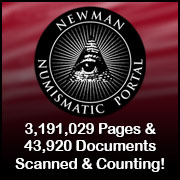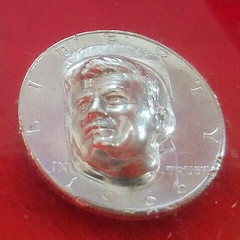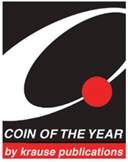
About UsThe Numismatic Bibliomania Society is a non-profit association devoted to the study and enjoyment of numismatic literature. For more information please see our web site at coinbooks.org SubscriptionsThose wishing to become new E-Sylum subscribers (or wishing to Unsubscribe) can go to the following web page link MembershipThere is a membership application available on the web site Membership Application To join, print the application and return it with your check to the address printed on the application. Print/Digital membership is $40 to addresses in the U.S., and $60 elsewhere. A digital-only membership is available for $25. For those without web access, write to: Charles Heck, Treasurer AsylumFor Asylum mailing address changes and other membership questions, contact Chuck at this email address: treasurer@coinbooks.org SubmissionsTo submit items for publication in The E-Sylum, write to the Editor at this address: whomren@gmail.com
BUY THE BOOK BEFORE THE COIN |
- WAYNE'S WORDS: THE E-SYLUM DECEMBER 13, 2020
- NEW BOOK: LARGE CENT 1793-1814 VARIETY GUIDE
- NEW BOOK: EXPLORING CURRENCY PLATE PROOFS
- BANKNOTE BOOK WEIHAIWEI CHAPTER PUBLISHED
- JEAN BELAUBRE (1931-2020)
- RICHARD L. HORST (1934-2020)
- NNP ADDS KOENINGS' REEDED EDGE HALF NEWSLETTER
- VIDEO: NATIONAL SILVER DOLLAR ROUNDTABLE
- VIDEOS: 2020 COLONIAL COIN EDUCATIONAL PROGRAMS
- AUDIO: COIN WORLD PODCAST WITH ROGER BURDETTE
- MORE COINS IN LUCITE: CHURCHILL, GOULD, KENNEDY
- NOTES FROM E-SYLUM READERS: DECEMBER 13, 2020
- QUERY: SECOND PHILADELPHIA MINT IMAGE ORIGIN
- QUERY: THE FIRST COINS OF ISRAEL
- VOCABULARY TERM: OPENWORK
- WILLIAM SPOHN BAKER (1824-1897)
- 2021 COIN OF THE YEAR NOMINATIONS
- THE NEW YORK SALE AUCTION LIII
- CLASSICAL NUMISMATIC GROUP TRITON XXIV SALE
- CANAAN BRONZE AGE SILVER DEBASEMENT
- THE COINAGE OF RHEGIUM
- READING ROMAN COINS
- BACKYARD TUDOR GOLD COIN HOARD FIND
- THE COINING HOUSE OF SEGOVIA
- LOUIS ELIASBERG'S BARBER HALF DOLLARS, PART II
- ADVENT COINS: ON THE ROAD TO BETHLEHEM
- PAPER MONEY DEPICTING JESUS
- BANK OF ENGLAND FATHER CHRISTMAS £5 POSTCARD
- MOVIE REVIEW: THE MILLION POUND NOTE
- U.S. POST-WWII GERMANY BARTER UNIT CERTIFICATES
- BEP CHOOSES ARCHITECTS FOR NEW FACILITY
- FORREST FENN FORTUNE FINDER FOUND
- UZBEKISTAN'S MINI GOLD BARS
- CASH, COINS AND COVID SEMINAR
- LOOSE CHANGE: DECEMBER 13, 2020
- BIG COIN: THE GIANT TOONIE
- BIG COIN: THE BIATEC MONUMENT
- FEATURED WEB SITE: WAR WORK TOKENS
Content presented in The E-Sylum is not necessarily researched or independently fact-checked, and views expressed do not necessarily represent those of the Numismatic Bibliomania Society.
WAYNE'S WORDS: THE E-SYLUM DECEMBER 13, 2020
 New subscribers this week include:
Darrell Luedtke courtesy John and Nancy Wilson; and
Chris Steenerson.
Welcome aboard! We now have 6,608 subscribers.
New subscribers this week include:
Darrell Luedtke courtesy John and Nancy Wilson; and
Chris Steenerson.
Welcome aboard! We now have 6,608 subscribers.
Thank you for reading The E-Sylum. If you enjoy it, please send me the email addresses of friends you think may enjoy it as well and I'll send them a subscription. Contact me at whomren@gmail.com anytime regarding your subscription, or questions, comments or suggestions about our content.
This week we open with three new books, two obituaries, updates from the Newman Numismatic Portal, and more.
Other topics this week include U.S. colonial coins, reeded edge half dollars, Gould patterns, the second Philadelphia Mint, the first coins of Israel, William S. Baker, Coin of the Year nominations, upcoming auction sales, the Royal Mint of Segovia, paper money depicting Jesus, the finder of Forrest Fenn's treasure, and two really, really big coins.
To learn more about U.S. Large Cent varieties, currency proofs, the National Silver Dollar Roundtable, Virginia Halfpence, openwork, the Half Noble of King Edward III, the Charles I gold Triple Unite, the coinage of Rhegium, Canaan silver, Tudor gold, the oldest psychiatric hospital in the world, the million pound note, the Giant Toonie, and Pistareen Mountain, read on. Have a great week, everyone!
Wayne Homren
Editor, The E-Sylum
NEW BOOK: LARGE CENT 1793-1814 VARIETY GUIDE
Back in April we discussed a new variety attribution guide by Robert Powers for the early U.S. Large Cents 1793-1795. Copies sold fast. He's continued his good work on the topic and has just published a larger work covering the series through 1814. E-Sylum supporter David Kahn Rare Coins has some in stock, and Dave Kahn submitted these thoughts. -Editor
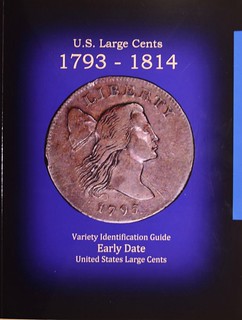 Some of you may recall that we offered a new Large cent variety attribution manual this past spring. Written by EAC member Robert Powers, and covering only 1793 to 1795 cents, it presented a very detailed attribution system that made a great deal of sense to me. Powers' system seemed familiar and comfortable since it used a general premise that I was taught 30+ years ago by my primary mentor in the Bust half dollar world, Dr. Michael Summers. Mike explained that I should learn to recognize Bust half dollar die marriages - especially the rare ones - as if they were familiar faces. The 20-odd copies we had of Powers' self-published book sold out in less than a week.
Some of you may recall that we offered a new Large cent variety attribution manual this past spring. Written by EAC member Robert Powers, and covering only 1793 to 1795 cents, it presented a very detailed attribution system that made a great deal of sense to me. Powers' system seemed familiar and comfortable since it used a general premise that I was taught 30+ years ago by my primary mentor in the Bust half dollar world, Dr. Michael Summers. Mike explained that I should learn to recognize Bust half dollar die marriages - especially the rare ones - as if they were familiar faces. The 20-odd copies we had of Powers' self-published book sold out in less than a week.
Now, Robert Powers is back with something way better. He's been using the pandemic to complete the work on his latest book, covering the entire Early Date cent series. We now have, "U.S. Large Cents 1793-1814, Variety Identification Guide" in stock and available. 274 pages that are packed with Powers' observations and ID keys, color photos throughout and printed in the USA. I am a big fan of this book, and highly recommend you get your copy soon. We have only 100 in stock.
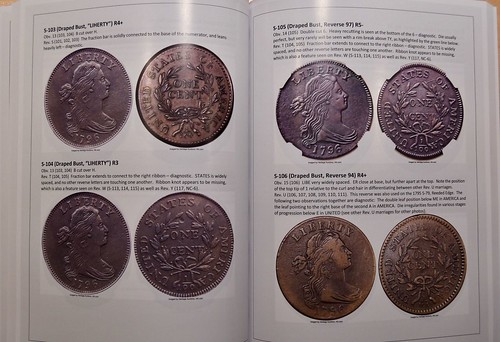
Thanks to Dave for these images and sending a review copy. This edition is much larger than the earlier one - it's softbound, has 247 unnumbered pages, and full color photos of every die marriage, 1793 thru 1814. Page numbers aren't entirely necessary; with coins ordered chronologically and by Sheldon variety it's easy to find the relevant pages.
Printed on glossy paper, the large color photos are clear and useful, often augmented with colored lines and labels pointing the reader to the relevant part of the coin. I found the edge photos for the 1794 Head of 1793 varieties very useful. Accessible to experts and beginners alike, I think this book will be handy and popular with Large Cent collectors. -Editor
For more information, or to order, see:
U.S. Large Cents 1793-1814 Variety Identification Guide, by Robert Powers
(https://www.davidkahnrarecoins.com/catalog/product/view/id/1775/s/u-s-large-cents-1793-1814-variety-identification-guide-by-robert-powers/category/122/)
To read the earlier E-Sylum article, see:
NEW BOOK: 1793-1795 LARGE CENT VARIETY GUIDE
(https://www.coinbooks.org/v23/esylum_v23n15a05.html)
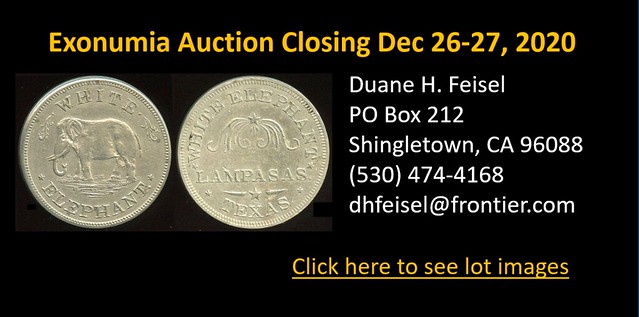
NEW BOOK: EXPLORING CURRENCY PLATE PROOFS
Chris Steenerson submitted this press release about his new resource for National Bank Note Research. Thanks. -Editor
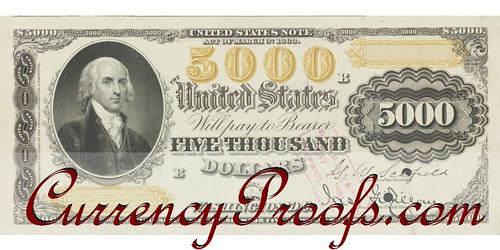
"Exploring The Certified Currency Plate Proofs" is a reference work indexing the National Bank Note plate proofs by state, bank charter, date period and denomination. The set of handbooks currently consists of 50,945 face and back proofs, divided into 333 volumes, in PDF format, with more coming soon to eventually total 400+ titles.
Charter Patron subscribers receive early access to the new titles and revisions as they become available. Charter Patrons receive links to the finished "alpha" release versions. We hope to move up the release timeline based on Patron and advertiser support! Charter Patrons also have the option to send a thumb drive (with a SASE) to be loaded up with the larger sets to avoid downloading delays.
There are currently 333 National Bank Note plate proof titles posted at www.CurrencyProofs.com. They are beta samples for testing and feedback. They contain about 20% of the images in the full set of handbooks, currently consisting of 50,945 face and back proofs, divided into 333 volumes. Their total size is 3Gb. The first full set totals 13Gb. SET 2.0 is estimated to reach ~37Gb. SET 3.0 in higher resolution should climb to ~65Gb. SET 4.0 will probably weigh in at ~120Gb. There are also many new titles planned for 2021 and beyond. Higher resolution images result in higher Gb files. Add Levels 2, 3, and 4 (details at www.CurrencyProofs.com) and lock in the low Launch rates!


____ Charter Patron LEVEL 1: SET 1.0 PLUS 3 upgrades, SETS 2.0 to 4.0 when released. $40.00
____ Charter Patron LEVEL 2: SET 5.0 PLUS 3 upgrades, SETS 6.0 to 8.0 when released. $40.00
____ Charter Patron LEVEL 3: SET 9.0 PLUS 3 upgrades, SETS 10.0 to 12.0 when released. $40.00
____ Charter Patron LEVEL 4: SET 13.0 PLUS 3 upgrades, SETS 14.0 to 16.0 when released. $40.00 or
____ Charter Subscription ALL LEVELS 1 to 4: ALL SETS 1.0 to 16.0 as released. $120.00 ($300. Value!)
Please select one option and mail with payment to:
Chris Steenerson
2493 W. 122nd Ave.
Westminster, CO 80234-3799
About the National Bank Note eBook collection:
The series provides a visual tour through the National Bank Note plate proofs held in the National Numismatic Collection at the National Museum of American History. These large size notes were issued from 1863 to 1929 by thousands of banks throughout the country and territories, in various denominations, during three Charter Periods. It was the most extensive series of paper money produced by the United States. The reference set also has 330 tables on 475 pages with over 116,500 words. The 4-500 completed titles, as planned, will include Overviews, Indexes and Close-ups by Denomination.
It is FREE to join the Currency Proof Club! View the current library posted online and help us spread the word. Just email your name, interests and ANA # (optional) to
chris@currencyproofs.com to register. The current Link Index PDF is available at the following link:
http://www.currencyproofs.com/jDbUa-RS/Steenerson's-National-Bank-Note-Plate-Proof-Series-Link-Index-%5bSET09%5d%5bSAMPLE%5d%5b333%5d.pdf
Please support the Currency Proof Club financially by subscribing to the Research Library.
Your support will help ensure continuous publication of this unique numismatic resource.
For more information, see:
www.CurrencyProofs.com
BANKNOTE BOOK WEIHAIWEI CHAPTER PUBLISHED
Owen Linzmayer publishes The Banknote Book, a useful, constantly updated electronic reference. The chapter on the banknotes of Weihaiwei is now available for $4.99. -Editor
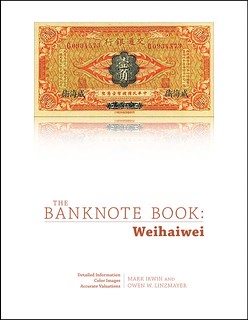 Mark Irwin has added another chapter to his cataloging opus with this week's publication of the following:
Weihaiwei (East and Southeast Asia)
Mark Irwin has added another chapter to his cataloging opus with this week's publication of the following:
Weihaiwei (East and Southeast Asia)
This 7-page catalog covers notes issued by the Bank of Communications from 1914 to 1927, the Bank of China in 1918, and the National Industrial Bank of China in 1924.
To read the complete article, see:
Weihaiwei chapter of The Banknote Book is now available
(https://banknotenews.com/?p=31635)

JEAN BELAUBRE (1931-2020)
Georges Depeyrot submitted this information on the passing of Jean Belaubre, former curator of the Musée de la Monnaie, Paris. Thank you. -Editor
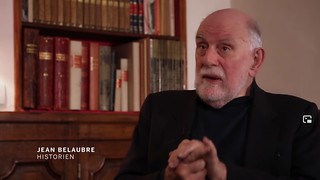 Jean Belaubre, former curator of the Musée de la Monnaie, Paris, died on December 10, 2020. Designer and creator of the permanent museum dedicated to the history of French money, at the end of the 1980s, he was no less illustrated in many related fields. He participated in the heyday of the Club Français de la Médaille journal (1970s and 1980s), signing many articles devoted to remarkable coins and the work of medal engravers, which fueled his reflection.
Jean Belaubre, former curator of the Musée de la Monnaie, Paris, died on December 10, 2020. Designer and creator of the permanent museum dedicated to the history of French money, at the end of the 1980s, he was no less illustrated in many related fields. He participated in the heyday of the Club Français de la Médaille journal (1970s and 1980s), signing many articles devoted to remarkable coins and the work of medal engravers, which fueled his reflection.
Trained economist and historian numismatist by passion, popularizer of talent, he published "Histoire numismatique et monétaire de la France médiévale (Numismatic and Monetary History of Medieval France)" (1986) then the "Dictionnaire de Numismatique médiévale occidentale (Dictionary of Medieval Western Numismatics)" (1996), while extending the Museum's adventure with works intended for the general public: "Histoire de la monnaie de l'Antiquité à nos jours (History of money from Antiquity to the present day)" (with R. Doty, former curator of the Smithsonian collection) (1986); "Les monnaies de France. Histoire d'un peuple (The currencies of France. History of a people)" (with B. Colin) (1992).
He had reserved for his retirement to treat the episode of Zéphirin Camélinat, director of the Mint, at the time of the Commune, in a memoir clarifying his facts and actions.
Open-mindedness and insatiable curiosity characterized this researcher who even undertook to interest Japan by winning the French medal in 1994 in an exhibition at the Shoto Museum in Tokyo!
Jean-Luc Desnier, his successor to the Monnaie de Paris coin cabinet, had organized the publication of a volume of Mélanges in 2001:
http://www.moneta.be/volumes/moneta_023.htm
The November 16, 1988 issue of Coin World carried a front page article about Jean Belaubre leading a tour of the museum. -Editor
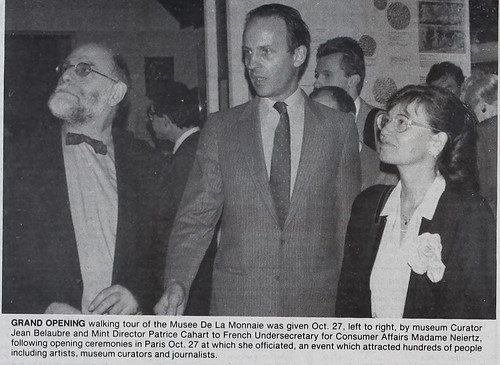
RICHARD L. HORST (1934-2020)
Herb Klug sent along word of the passing of Richard L. Horst. Thanks. Here's an excerpt from his online obituary. -Editor
 Richard L. Horst, 86, passed away November 10, 2020. He is survived by his wife, Joyce, four children, five grandchildren and a great grandchild. He was born in St. Paul, Minnesota in 1934. He was a natural tinkerer and was involved with ham radios with his school friends. He put himself through the University of Minnesota by working at the local appliance repair shop and graduated in 1956 with a Bachelor of Science degree in Electrical Engineering.
Richard L. Horst, 86, passed away November 10, 2020. He is survived by his wife, Joyce, four children, five grandchildren and a great grandchild. He was born in St. Paul, Minnesota in 1934. He was a natural tinkerer and was involved with ham radios with his school friends. He put himself through the University of Minnesota by working at the local appliance repair shop and graduated in 1956 with a Bachelor of Science degree in Electrical Engineering.
Richard was employed by Univac in St. Paul after graduation. He also served in the U.S. Army Reserve for seven years. He married Joyce Malmgren in 1957 and they celebrated their 63rd anniversary this year. In 1979, he moved to Colorado Springs, Colorado to work at Hewlett Packard (HP). After HP split into HP and Agilent Technologies, he moved to Agilent Technologies and retired from there in 1999.
He was a lifelong history buff and numismatic expert, volunteering countless hours at the American Numismatic Association and teaching courses in Civil War currency. He was highly respected in the field and received a volunteer of the year award for his efforts. He was a member of the Beer and Battlefield group of friends, going on historical tours. He enjoyed landscaping, cooking, and having a beer with friends and family. He sang in the church choir and lived an active and full life until his last days. He will be missed greatly by his family, friends, and colleagues, friends.
ANA Edward C. Rochette Money Museum Curator / Director Doug Mudd writes:
"We taught several classes together for Summer Seminar over the last decade. He was a great friend to the ANA and a numismatist who loved to share his immense knowledge and experience, whether as a volunteer at the museum, as a dealer at a show or as an instructor at Summer Seminar. From German thalers to Civil War paper money he was a font of detailed and expert information from historical background to counterfeit detection. I will miss him..."
To read the complete article, see:
Richard L. Horst
(https://www.cappadonafh.com/obituary/Richard-Horst)

NNP ADDS KOENINGS' REEDED EDGE HALF NEWSLETTER
The latest addition to the Newman Numismatic Portal is the Reeded Edge Half Newsletter Project Coordinator Len Augsburger provided the following report. -Editor
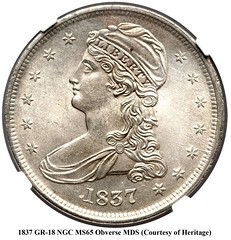
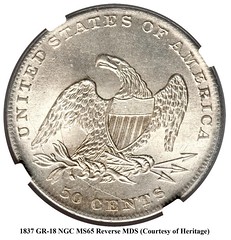
Newman Portal Adds Koenings' Reeded Edge Half Newsletter
Launched in 2019, Jim Koenings' Reeded Edge Half Newsletter is dedicated to study of the reeded edge Capped Bust half dollars struck from 1836-1839. An extension of the Capped Bust half dollar series, the Reeded Edge pieces represent a number of changes, including transition to the steam press and the ability to impart the reeded edge at the time of striking. Weight, fineness, and diameter were additionally altered per legislative and technical requirements. These pieces are sufficiently different from the 1807-1836 half dollars and usually collected as a separate type, even if highly similar at first glance.
The four-year series contains 56 die marriages, with the standard reference being Dick Graham's A Registry of Die Varieties of Reeded Edge Half Dollars (2012). The Overton reference, ubiquitous for Capped Bust halves (1807-1836), does not include this series. Koenig's Reeded Edge Half Newsletter focuses on the most common 38 die varieties and explores one in depth each month. The most recently published issue, for November 2020, cover the 1837 GR-18. This variety is most readily attributed by the reverse die crack running from the eagle's left wing to (CE)N(TS).
Koenings has further written on the Reeded Edge series in the John Reich Journal, published by the John Reich Collector Society (JRCS), and recommends JRCS membership for all collectors interested in this series.
Images: 1837 50c, GR-18, courtesy of Heritage Auctions
Link to Koenig's Reeded Edge Half Newsletter:
https://nnp.wustl.edu/library/publisherdetail/540192
Link to John Reich Journal on Newman Portal:
https://nnp.wustl.edu/library/publisherdetail/518721
Link to John Reich Collector Society webpage:
https://www.jrcs.org/
VIDEO: NATIONAL SILVER DOLLAR ROUNDTABLE
These are selections from the David Lisot Video Library that feature news and personalities from the world of coin collecting. David has been attending coin conventions since 1972 and began videotaping in 1985. The Newman Numismatic Portal now lists all David's videos on their website at:
https://nnp.wustl.edu/library/multimediadetail/522852
Here's one on the founding of the National Silver Dollar Roundtable. -Editor
Founding of National Silver Dollar Roundtable (NSDR).
VIDEO: 10:20. (June 1, 2016)
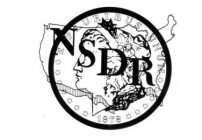 John Highfill, Founder, National Silver Dollar Roundtable, David Lisot, Interviewer, CoinTelevision.com.
John Highfill, Founder, National Silver Dollar Roundtable, David Lisot, Interviewer, CoinTelevision.com.
In 1982 a disagreement about grading coins caused the founding of a new non-profit organization devoted to collecting silver dollars. The National Silver Roundtable was the brainchild of silver dollar dealer John Highfill. Learn the story of how John got together the major silver dollar collectors of the day and founded the NSDR.
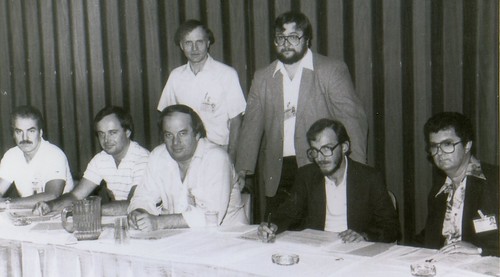
National Silver Dollar Roundtable 1982 Board of Governors
An excerpt of the video is available for viewing on the Coin Television YouTube Channel at:
https://youtu.be/thrf881Py3A

VIDEOS: 2020 COLONIAL COIN EDUCATIONAL PROGRAMS
Videos of all six of the 2020 Colonial Coin Collectors Club Educational Programs (recorded November 12-14, 2020) are now available on the C4 Website. The videos were produced by Lianna Spurrier. -Editor

The Long and Twisted Road to Virginia Halfpence
Dr. Roger Moore
Colonial History of the Caribbean, Central, and South America
Dr. David Menchell
Introduction to British and Irish Coppers Used in Colonial North America
Jeff Rock
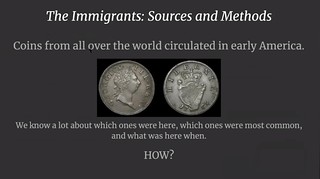 The Immigrants: Sources and Methods
The Immigrants: Sources and Methods
John Kraljevich
Colonial 101
Jim Glickman
Continental Currency: Patriotism in Print
Leo Shane
C4's Jim Glickman adds:
"We plan to make virtual programming an ongoing part of C4's educational offerings, even after we resume in-person gatherings."
To watch the videos, see:
Media
C4 Convention 2020
(https://colonialcoins.org/c4media/)
I had been unable to watch these live because of my E-Sylum editing duties that day, but have been able to catch up on a few presentations via these videos. I enjoyed John Kraljevich's talk the other night. -Editor

AUDIO: COIN WORLD PODCAST WITH ROGER BURDETTE
Author Roger Burdette was interviewed recently on the Coin World podcast - check it out! -Editor
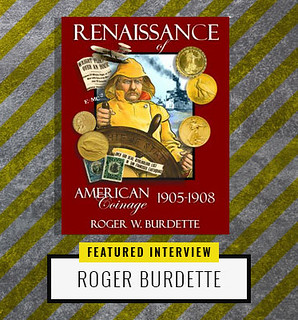
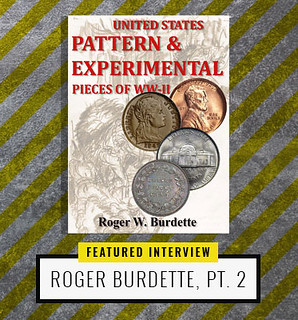
Part 1
Jeff and Chris discuss the record-breaking sale of the recently-discovered, third known Eid Mar aureus and interview Roger Burdette about his three-volume series The Renaissance of American Coinage.
Part 2
Jeff and Chris's conversation with Roger Burdette continues this week, focusing on Burdette's United States Pattern and Experimental Coinage of World War II. Chris shares what he's reading, and he and Jeff review an issue of Coin World published in 1992.
To listen to the podcast episodes, see:
Renaissance Man: Eid Mar aureus and Roger Burdette Part I
(https://www.coinworld.com/news/us-coins/cwpod_ep087)
Twice as nice: continuing the conversation with Roger Burdette
(https://www.coinworld.com/news/us-coins/cwpod_ep088)

MORE COINS IN LUCITE: CHURCHILL, GOULD, KENNEDY
Bruce Perdue writes:
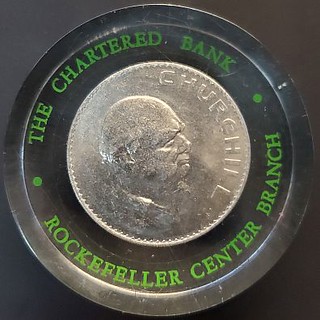 "I was of course interested to see more Lucite encased coins this week. I passed on sending you an image of the toilet seat and many other Lucite encased coins that I own. I am enclosing one more since it ties into two articles from the December 6, 2020 (v23n49) issue. I have two Churchill crowns encased in Lucite from, "The Chartered Bank - Rockefeller Center Branch". It's 2 1/4 inches in diameter and 1 inch high. The other is 3 inches by 3/4 inch, otherwise identical.
"I was of course interested to see more Lucite encased coins this week. I passed on sending you an image of the toilet seat and many other Lucite encased coins that I own. I am enclosing one more since it ties into two articles from the December 6, 2020 (v23n49) issue. I have two Churchill crowns encased in Lucite from, "The Chartered Bank - Rockefeller Center Branch". It's 2 1/4 inches in diameter and 1 inch high. The other is 3 inches by 3/4 inch, otherwise identical.
"To further tie it into the Bibliomania aspect of this newsletter, while visiting Blenheim Palace in 2008 it was recommended to me that if I really wanted to understand Winston Churchill I should read, "Fortune's Daughters" the story of Jennie Churchill, Winston's mother, and her 2 sisters. They were New York City socialites who came to London and married aristocracy. It is an interesting look into his mother and how the aristocracy behaved and raised their children and how it shaped Winston.
"My local library thru interlibrary loan obtained a copy from the University of Illinois Champaign campus. I was the first to read it. "
Lev Linkner writes:
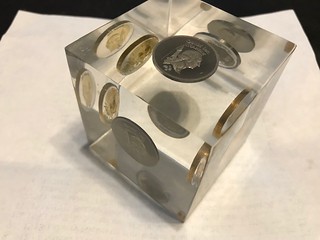 "I found your Lucite article interesting. I remember in the 50s and 60s many coins were put it Lucite. A few years ago I purchased this probably unique Lucite block of Gould Patterns. It is not referenced in Burdette's book or elsewhere. I imagine it was made for an executive at Gould Manufacturing in Cleveland or for advertising around 1978. All pieces in various metals are very rare. Even though it is thought that the Lucite decreases its value (it does), this is a historic Lucite block.
"I found your Lucite article interesting. I remember in the 50s and 60s many coins were put it Lucite. A few years ago I purchased this probably unique Lucite block of Gould Patterns. It is not referenced in Burdette's book or elsewhere. I imagine it was made for an executive at Gould Manufacturing in Cleveland or for advertising around 1978. All pieces in various metals are very rare. Even though it is thought that the Lucite decreases its value (it does), this is a historic Lucite block.
"Lucite is a brand name for Poly (methyl methacrylate) and other brands may have produced the encased coins we encounter."

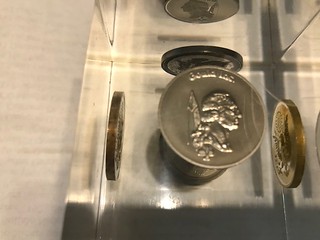
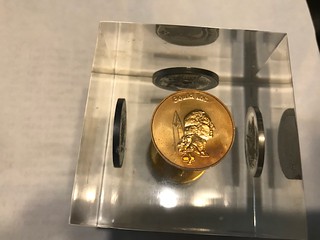

Lev included these references:
Gould Inc. Patterns
(http://www.smalldollars.com/dollar/page02.html)
NEW BOOK: INTERNATIONAL NICKEL & GOULD PATTERNS
(https://www.coinbooks.org/v22/esylum_v22n19a02.html)
Lev Messick writes:
"Just thought you would like to know there is a Lucite paper weight and pen holder with Harry's name in the Lucite as well on eBay for $75.00 right now. I remember Harry well from shows here at Long Beach."

To read the complete lot description, see:
Lucite Paperweight desk 3d Silver Coins red owned by numismatist Harry Forman
(https://www.ebay.com/itm/Lucite-Paperweight-desk-3d-Silver-Coins-red-owned-by-numismatist-Harry-Forman/124291196159)
Thanks, everyone! Great topic. Each item was more amazing than the last. I'd never seen a pop out repousse Kennedy half! All three coins look like the product of the August Frank company. -Editor
To read the earlier E-Sylum articles, see:
NEW BOOK: POP OUT REPOUSSE COINS, 3RD EDITION
(https://www.coinbooks.org/v20/esylum_v20n01a05.html)
MORE COINS IN LUCITE
(https://www.coinbooks.org/v23/esylum_v23n49a14.html)
THE 1965 COMMEMORATIVE CHURCHILL CROWN
(https://www.coinbooks.org/v23/esylum_v23n49a31.html)

NOTES FROM E-SYLUM READERS: DECEMBER 13, 2020
Castorland Jeton Obsessive Date
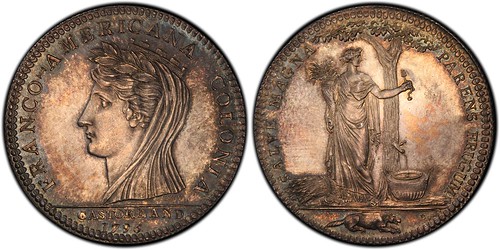
Chester Sullivan writes:
"Not every Monday morning does The E-Sylum toss up a gem for me, but when it does it's usually a stunner. A few weeks back Dick Johnson's entry of obsessive date was a big one. Original-dies Castorland jetons were minted from circa 1796 up to the "pointing hand" edge mark period of June 13, 1845-Oct. 31, 1860. And they all carry the date 1796. I cherish a copy of Dick's Encyclopedia and have run through it numerous times, but I've consistently overlooked that particular entry. Thanks for calling it to mind."
Glad to help! -Editor
To read the earlier E-Sylum articles, see:
HELP SOUGHT FOR CENSUS OF CASTORLAND JETONS
(https://www.coinbooks.org/esylum_v18n16a15.html)
VOCABULARY TERM: OBSESSIVE DATE
(https://www.coinbooks.org/v23/esylum_v23n48a16.html)
NOTES FROM E-SYLUM READERS: DECEMBER 6, 2020 : Frozen Dates
(https://www.coinbooks.org/v23/esylum_v23n49a13.html)
Gold Dust Avenue and Pistareen Mountain
 Regarding our question about money and numismatic place names,
Cole Hendrickson writes:
Regarding our question about money and numismatic place names,
Cole Hendrickson writes:
"There is a street near where I live named Gold Dust Avenue. I do not know the history behind the name but always found it interesting."
Thanks! I learned of another one when I watched John Kraljevich's C4 talk the other night. Get this - there is a Pistareen Mountain in New Hampshire. It got its name because it was sold for a pistareen! -Editor
To read the earlier E-Sylum article, see:
LOOSE CHANGE: NOVEMBER 29, 2020 : Moneyed Street Names
(https://www.coinbooks.org/v23/esylum_v23n48a34.html)
NOTES FROM E-SYLUM READERS: DECEMBER 6, 2020 : Gold Street and Thousand Dollar Road
(https://www.coinbooks.org/v23/esylum_v23n49a13.html)
Austrian World War I poster
Jeff Garrett writes:
"I was exploring the Smithsonian web site and the exhibit "Advertising War". This WWI poster really caught my attention. I'm sure there is a great story behind it."
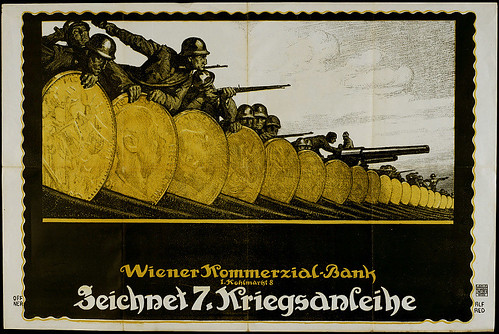
Zeichnet 7. Kriegsanleihe
(Subscribe to the 7th War Loan)
Austrian World War I poster by artist Alfred Offner for the Vienna Commercial Bank, 1917. Depicted are Austrian soldiers with guns drawn crouching behind a wall of gold Austrian coins.
Thanks. Neat image - I'd never seen this before. -Editor
To read the complete article, see:
A Global War
(https://americanhistory.si.edu/advertising-war/global-war)
Utrecht Bookcase Mural
Pat McBride writes:
"This is cool. Numismatic book mural on the boring side of ANA headquarters? "

Known for his incredible street art illusions, Jan Is De Man has created a charming mural in Utrecht that's bringing together the community. In collaboration with graffiti writer and tattoo artist Deef Feed, he transformed the anonymous facade of a building into a marvelous bookcase. And the best part is that all the literary works featured were suggested by local residents.
The project began thanks to friends of Is De Man's, who live in the building. They'd been asking him to create a mural on their building for quite some time, but his original idea was quite different. Originally, he'd thought to paint a large smiley-face, as research shows that people's moods are lifted when they see a smile. However, after studying the shape of the building, he settled into the idea of transforming it into a bookcase. He then called in Deef Feed, who he's worked with in the past, to help make it happen.
Very cool. Nicely done. A numismatic bookshelf mural would be great. -Editor
To read the earlier E-Sylum article, see:
Street Artists Transform an Ordinary Building into a Spectacular Bookcase
(https://mymodernmet.com/utrecht-street-art-illusion-jan-is-de-man/)
Buy it Now! Oops, Too Late...
Author Dave Lange writes:
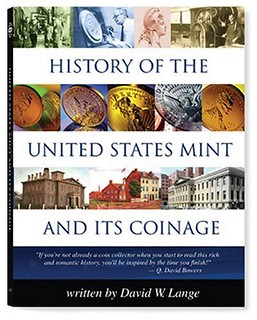 "I was puzzled by a recent development and finally figured out what's happening. For a long time I've listed for sale my Whitman-published book History of the United States Mint and its Coinage, but there had been very few takers in the past few years. This didn't surprise me, since the book is 15 years old, and most sellers had new copies available at $10-15 for quite awhile. Then, last week I received five orders in as many days through Amazon at my list price of $24.95. Pleasantly surprised, I took a look to see what others were selling the book for on Amazon and discovered that new copies are listed at $65-75!
"I was puzzled by a recent development and finally figured out what's happening. For a long time I've listed for sale my Whitman-published book History of the United States Mint and its Coinage, but there had been very few takers in the past few years. This didn't surprise me, since the book is 15 years old, and most sellers had new copies available at $10-15 for quite awhile. Then, last week I received five orders in as many days through Amazon at my list price of $24.95. Pleasantly surprised, I took a look to see what others were selling the book for on Amazon and discovered that new copies are listed at $65-75!
I checked both the Whitman website and Wizard Supply, and sure enough they no longer have any for sale. With just two copies left in my own inventory I took a bold step and raised the price $5, only to have a sale within the hour. By the time anyone reads this I'm confident that I, too, will be sold out of that title.
It reminds me of the old saying that's been applied by others in reference to numismatic literature, "When a book is in print you can't sell it any price, and when it's out of print you can't buy it at any price..." That's perhaps not as true today as it was in the pre-internet era, but I have proof that it still applies in some instances."
Well, that's good news for bibliophiles! Reports of the death of physical books have been greatly exaggerated. But it's never easy for authors and publishers. -Editor
Author Roger Burdette writes:
"The obvious "lesson learned" is to publish your new book as "Out of Print," then don't print any until the after market price goes through the roof! Another, but more painful option, is to publish the new book accompanied by an obituary of the author.
"Making a profit on coin books can be tough on the author!"
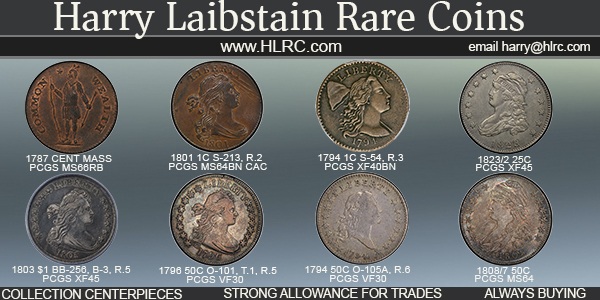
QUERY: SECOND PHILADELPHIA MINT IMAGE ORIGIN
Pete Smith submitted this interesting question for our readers. -Editor

I was amused by two images that I recently found in the archives of the Library Company of Philadelphia. Readers of The E-Sylum should recognize the building on the left as the Second Philadelphia Mint. It was located at the northwest corner of Chestnut and Juniper with South Penn Square on the north. It was about a half-block east of Broad Street.
I was not familiar with the building on the right. It was built as the 7th Presbyterian Church at the southeast corner of Broad and South Penn Square. Its back was next to the Second Mint which can be seen at the left side of the image.
The Mint cornerstone was laid on July 4, 1829, and the building was ready for occupancy by January 1833. Construction of the Third Mint was completed in 1901 and the Second Mint was shortly demolished to be replaced by the Widener Building.
The church was built in 1842. The congregation was renamed The Tabernacle Church with their last meeting there in 1884. The church was replaced by the ornate Betz Building which was built in 1892 and demolished in 1926.
Thus for fifty years there were two Grecian temples on the same block in Philadelphia. Did any drunken patron ever wander into the wrong building?
I recognized the Second Building but not this specific image and I don't know where it was first published. Can any E-Sylum reader identify the first place it was published?
Interesting question. Can anyone help? My guess (and it's only a guess) is that these two similar sketches may have been prepared for a guidebook of downtown Philadelphia. I tried a Google image search but came up empty - all it could tell me was what we already knew - the Mint building is an example of Classical Architecture. -Editor
THE BOOK BAZARRE
QUERY: THE FIRST COINS OF ISRAEL
Stephen Olson submitted this request for additional information about the first coins minted by the state of Israel. -Editor
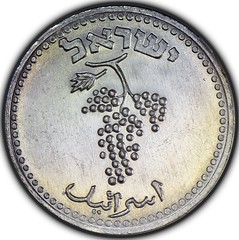
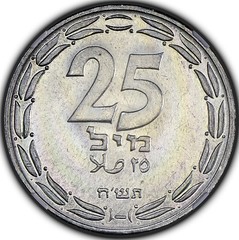
These coins were the first ones minted by the State of Israel in 1948. They were mostly (perhaps exclusively) minted in the town of Holon, shortly after Israel's Independence Day on May 14, 1948. There are a number of different versions to this story, but I have gleaned some basics in my research. When the British withdrew their mandate, they took with them much of the circulating coinage, which were primarily Palestine prutas & mils. This left the fledgling State of Israel in a precarious situation financially, as well as militarily.
The decision was made to create a coinage of their own, with only what they had, through what they could; so the Mint at Holon was created using the facilities of a jewelry business in town. Aluminum was procured, dies were made & the minting of Israel's first coin was commenced. One die was stored in Jerusalem, while the other remained in Holon. Every day required that the Jerusalem die be transported to Holon via roads, through much hostile territory. This greatly reduced the number of coins that could be minted daily, but did provide the needed controls so that the value of each piece could be determined. The designs were based on ancient motifs; a cluster of grapes on the obverse & two stylized olive branches encircling the value 25 on the reverse. Both of these patterns were based on Jewish coins struck during the Bar Kochba Revolt of 132-135 AD. By the end of 1948, a total of of 42,650 Israel 25 Mils pieces were minted.
So much in this story truly points to the miracle that is Israel! Not only did a nation come into being in one day, as prophesied by the prophet Isaiah (Isaiah 66:8), but even the quantity of 42,650 minted in 1948 is considered prophetic (Ezra 2:64), as it is so close to the number of Jews that returned to Judah from Babylon (42,360). Probably nothing is as profound however, as the bravery of those minting the coins who were in extreme danger, from a bombardment of rocket & mortar fire around them.
The nation's mint workers were under constant danger, while working to supply the financial survival of their nation. What Patriots these men were! These coins, perhaps as few others, truly contain a storied history of sacrifice & bravery by those who brought them into being. The rather amazing thing about them today is that they are still available in XF to AU condition for very reasonable prices online. I have recently seen them on eBay for between $95.00 to $200.00!
I did locate an article by David Alexander on the PMG Collectors Society site, from which I took the above images. Can anyone provide or point us to additional information on these? Thanks. -Editor
To read the complete article, see:
Select Israeli Coins
25 Mils, 1948 - Israel's First Coin Issue
(https://notes.www.collectors-society.com/WCM/CoinView.aspx?sc=582835)

VOCABULARY TERM: OPENWORK
Dick Johnson submitted this entry from his Encyclopedia of Coin and Medal Terminology. Thanks. -Editor
Openwork. A pierced coin or medal, with an opening made as part of its artistic design, or cut out at a later time. Coins are found with square or round holes in the center, with little other openwork design. Openwork medals are somewhat more artistic in that the open area is usually not in the center but appears elsewhere in the design, as part of the artistic expression. All openwork is cut entirely through the item forming the most severe treatment and allowing showthrough with a view of any thing placed behind it.
Sometimes the background or some portion of the field is pierced out to give emphasis to the device. Many of the higher ranked decorations are pierced to give them this element of device emphasis and because this is so rarely done – because of the high cost – it gives these decorations an exclusiveness in the medallic field.
As a design element openwork must be worked into both obverse and reverse design. Like statues and other sculpture in-the-round, openwork is also considered as NEGATIVE SPACE, that is, the space is not filled with matrix (the metal) or design. Because of this removal, openwork is similar to silhouetting in three ways: the matrix is removed, the outlining gives it a "hard edge," to the design and permits showthrough of anything behind the item. Silhouetting is the cutting around the edge, while openwork is the cutting out entirely within the object. See silhouette.
Openwork created by the designer of the item is considered legitimate and what was intended. Openwork that is done after the numismatic item has been issued is considered by some people as the most egregious form of graffiti. Examples include both cutout coins and medals to create a form of numismatic jewelry. The cutout Columbian Commemorative Half Dollar of 1892-93 illustrated here is perhaps the most notable (or notorious) example depending upon a person's viewpoint.
How openwork is obtained. Openwork on cast objects present no difficulty in their formation. It is just as easy to form an object with openwork by casting as it is a solid object.
However, for struck objects, openwork requires great attention and tooling. Such openwork is produced by any of several ways: (1) pre-forming the blank by piercing the strip stock before the blank is cutout; (2) by piercing as one step in the use of a progressive die (see combination die), (3) by piercing with a piercing die on a separate run through a punch press after the piece is struck; or 4) by handworking with a jewelers saw.
Tooling for piercing is made of the hardest tool steel – drill rod – to effect the pierced opening. In effect, the steel punch pushes the soft metal through the piercing die, a tool with a hard edge surrounding the aperture made to the exact configuration of the required opening. The punch plate holds the punch die and it too has an opening in it (somewhat larger than the aperture in the die). The punch pushes the metal being removed through openings in both of these and it falls below as scrap. See piercing.
Openwork coins and tokens. The early cash coins of China with their square hole in the middle – among the first such numismatic objects with openwork – were created with the square hole for the utilitarian purpose of carrying many coins on a square stick. The casting of the coins provided little difficulty as casting can easily create openwork.
In modern times coins with openwork are struck with combination dies, which with one blow can pierce, blank and emboss the design all in one blow. It is done in stages, at the first position the blank strip is pierced, at the second position the relief design is struck and the third position the piece is blanked out of the strip. The strip moves in a prescribed distance to keep each function in close register.
Tokens, as transportation tokens, with many kinds of openwork centers, are typically struck with combination dies in this manner. An official of Osborne Coining, Charles Stegman, received U.S. patent number 3,338,084 in 1967 for the progressive die to strike, blank and perforate such tokens in one cycle of the press.
Openwork medals. The design dictates where a medal will be pierced and the quantity dictates how it will be pierced. If only a small quantity is required it is cost effective to hand jigsaw the needed pieces. If a large quantity is required (say, over fifty) a piercing tool is created by a tool and diemaker. It includes a punch, a die, a punch holder and a plate; sometimes a nest is also required for a critically designed piece to rest in the exact position to be pierced.
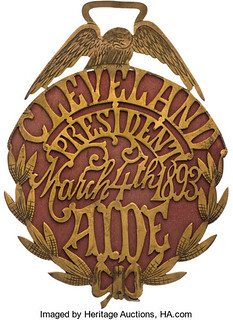 Illustrated is an openwork badge from the Grover Cleveland Inauguration of 1893. The Aide Badge was heavily pierced, the design is chiefly typographic, mostly lettering. A diestruck spread-wing eagle and a separate wreath were affixed to a thin, flat sheet brass that was probably hand jigsawed as the survival quantity of these badges does not indicate a large production. The fabrication brought all the separate elements together.
Illustrated is an openwork badge from the Grover Cleveland Inauguration of 1893. The Aide Badge was heavily pierced, the design is chiefly typographic, mostly lettering. A diestruck spread-wing eagle and a separate wreath were affixed to a thin, flat sheet brass that was probably hand jigsawed as the survival quantity of these badges does not indicate a large production. The fabrication brought all the separate elements together.
A Belgian medal, shows a pierced area – the small window in a prison door – on one side a woman brings food to a prisoner, on the other the prisoner reaching for the food. A more modern piece is an issue of the Society of Medalists showing both beauty and the devil looking into a mirror, the openwork area. See illustrations.
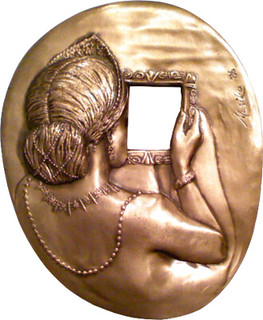
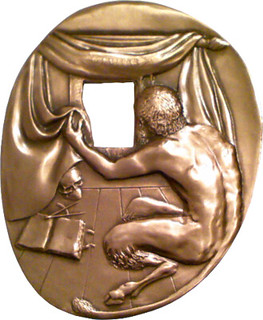
While a hole in a medal for suspension is technically openwork, it is not always so. If the artist intends it to be drilled the designer often includes a limiting guide, as a circle identifying the locus where the hole is to be made. When cataloged such an intended hole is noted as a drill hole. A hole drilled into any numismatic item not intended by the designer is considered vandalized.
Decoration with openwork. Designers of high ranking decorations have employed openwork to the greatest degree. Since elaborate tooling is required for the piercing this process is expensive but it adds the greatest amount of exclusiveness to the piece.
The United States Congressional Medal of Honor has openwork around a central star and within a wreath. This requires not one but two piercing runs because of the closeness of pierced areas to each other.
Cutout coins and medals. Anyone with a jewelers saw, a drill, a vise and a great deal of patience can cut an open area in a coin or medal. Generally a large piece is chosen with a portrait, device or design element that can be recognized after it is cutout. The design remaining must be attached to some portion of the rim (if the central device was entirely cut around it, obviously, it would fall out). In so doing, the entire design on the opposite side is destroyed.
The legend for such a cutout coin is a major problem, in that some cutout items omit this, but if it is cutout a portion of it is left connected to the rim. Columbus portrait on the obverse and his ship on the reverse of the Columbian Commemorative half dollar are excellent examples of cutout coins. See cutout.
Openwork in a coin or medal design that is not pierced – but intended to mean hollowed out – is called voided, the term from heraldry. A French coin, created for circulation in Canada and Louisiana Territory and listed in Breen (278) has a cross on the reverse and is described as a voided cross. It bears an outline of a square-arm cross that is empty of design in the interior, precisely the meaning of voided.
Openwork as the design. In 1930 a Pittsburgh inventor (Ollie S. Letzkus) received a design patent for an openwork item he called a Shadowgraphic Token. It was made of sheet brass with perforated openings, which, when held to a light cast a shadow of a design. His patented design (D83,734) formed the shadow of Christ's head. While an ingenious design, little more was done with his creation.
Openwork also includes filigree – lace-like openwork design – sometimes found on the border to bezels or plaques. The French word for openwork in coins and medals is ajoure. The use of the word "perforated" is discouraged in the numismatic field as it does not have the more exact meaning of similar terms listed here.
Reference:
NC12 {1988} Breen, p 48.
Looking for the meaning of a numismatic word, or the description of a term? Try the Newman Numismatic Portal's Numismatic Dictionary at: https://nnp.wustl.edu/library/dictionary
Or if you would like a printed copy of the complete Encyclopedia, it is available. There are 1,854 terms, on 678 pages, in The Encyclopedia of Coin and Medal Technology. Even running two a week would require more than 19 years to publish them all. If you would like an advance draft of this vital reference work it may be obtained from the author for your check of $50 sent postpaid. Dick Johnson, 139 Thompson Drive, Torrington, CT 06790.
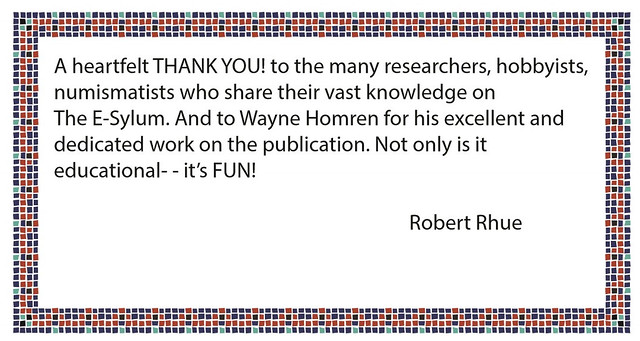
WILLIAM SPOHN BAKER (1824-1897)
John Lupia submitted the following information from the online draft of his book of numismatic biographies for this week's installment of his series. Thanks! As always, this is an excerpt with the full article and bibliography available online. This week's subject is Philadelphia collector William Spohn Baker. -Editor
 Baker, William Spohn (1824-1897), Philadelphia, Pennsylvania. Author of Medallic Portraits of Washington.
Baker, William Spohn (1824-1897), Philadelphia, Pennsylvania. Author of Medallic Portraits of Washington.
Baker was a Conveyancer, Collector of Art, Prints, Medals and Rare Books, Archaeologist, Author, Educator, Antiquarian, and Banker.
He was born in Philadelphia, Pennsylvania, 17 April, 1824, son of George Nice Baker (1788-1859), and Ann Keyser (1792-1867), "was a great-great-granddaughter of Dirk Keyser, who settled in Germantown in 1688. His great-grandfather, Michael Baker, who became a resident of this city in 1740, and his grand-father, Michael Baker, Jr., served during our war for independence, the former as a private and the latter as a lieutenant in the artillery battalion commanded by Colonel Jehu Eyre. His great-grandfather, Captain George Nice, also commanded a company of the Second Battalion Philadelphia Artillery Militia."
He was educated in Philadelphia's private schools and entered the office of Andrew D. Cash, Esq., with whom he studied conveyancing. He practiced this profession for some years, and then turned his attention to literary pursuits and historical research. He discovered Washington's campsite at Schuylkill Falls, Pennsylvania, around the time of the battle of Brandywine. He was recognized as the foremost authority in the United States on Washington and Washingtoniana.
He was married on May 12, 1853, to Eliza Downing, daughter of Richard and Jane Bartleson Rowley, and is survived by a daughter, Laura, wife of Henry Whelen, Jr., of Philadelphia.
He was elected a member of the Historical Society of Pennsylvania April 28, 1873, and of its Council in 1885, and since 1892 one of its Vice-Presidents.
He was a member of the Pennsylvania Society of the Sons of the Revolution, of which he was a member of its Board of Managers and chairman of the important " Committee on Memorials."
He was a member of the American Philosophical Society and served as it Curator; the Council of the Historical Society of Pennsylvania, and since 1885 has been vice-president of the Pennsylvania Academy of Fine Arts.
He was also a member of the American Historical Association; the American Numismatic and Archaeological Society of New York; the New Jersey Historical Society; the Society of the War of 1812; the Colonial Society of Pennsylvania, of which he was a member of the Board of Managers ; the German Society ; and the Netherland Society, serving one term as President. He was also a director of the School of Design for Women from 1877 to 1881; in the Pennsylvania Academy of the Fine Arts he was a director from 1876 to 1890, and Vice-President from 1885 to 1890 ; a director of the Athenaeum of Philadelphia from 1888 to his death ; and a director of the Commercial National Bank.
Mr. Baker possesses a collection of 1,100 engraved portraits of George Washington which is the most complete that is known, and his number of medals of Washington is second only to that of William S. Appleton, of Boston, while his collection of biographies of Washington is the most noted in existence comprised of over 500 books and pamphlets.
He was a regular contributor of articles to Pennsylvania Magazine, and published fifteen books on engravers and engraving and George Washington and Washingtoniana.
On September 8, 1897, he died at his residence on Arch Street, Philadelphia.
To read the complete article, see:
BAKER, WILLIAM SPOHN
(http://www.numismaticmall.com/numismaticmall-com/baker-william-spohn)
To read earlier E-Sylum articles, see:
THE COLLECTION OF WILLIAM SPOHN BAKER
(https://www.coinbooks.org/v22/esylum_v22n45a19.html)
THE SELLING OF THE BAKER COLLECTION
(https://www.coinbooks.org/v23/esylum_v23n08a30.html)
DWIGHT MANLEY ACQUIRES BULK OF BAKER COLLECTION
(https://www.coinbooks.org/v23/esylum_v23n09a28.html)
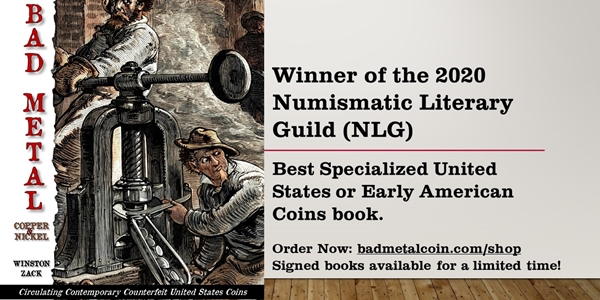
2021 COIN OF THE YEAR NOMINATIONS
In a December 11, 2020 Numismatic News article, Maggie Judkins reported on the nominees for the 2021 Coin of the Year awards. -Editor
The nomination process for the 2021 Coin of the Year awards looked a bit different this year, but the program is well under way despite travel and gathering restrictions due to COVID-19. One-hundred nominees – 10 coins in each of 10 award categories – emerged after the Nominating Committee met virtually Nov. 3, 2020, to consider 400 coin nominees curated by more than 45 issuing entities from around the world.
The 38th annual awards program, honoring coins dated 2019 and to be presented in early 2021, is presented by World Coin News and sponsored by The Journal of East Asian Numismatics.The competition begins each year when the committee convenes to select the nominees.
"Our COTY Nominating Committee traditionally has met in person to review and nominate coins from a large printed catalog of potential candidates," explained Tom Michael, COTY coordinator. "The pandemic made that impossible in 2020, so our team created digital files, devised a two-step nomination process and moved our in-person meeting onto a virtual platform. The Nominating Committee was so pleased with the efficiency of this new approach that we are already planning to adopt many of its elements permanently."
The change in process also had positive effects on the way coins were nominated, resulting in a broader scope of nominees.
"Completing the first phase of COTY nominating independently, rather than in a group setting, put the spotlight on some of the strengths inherent in our committee," said Michael. "We all seem to agree on certain coins, but our backgrounds are so diverse that everyone finds a few great coins that the others did not notice.
"The result of this year's restructured nominating procedure is a wonderful selection of 100 nominees in 10 categories, from more than 45 countries, which will certainly challenge our world-class Judging Panel as they cast their votes," he said. "You'll note that some subjects, the 50th Anniversary of the Apollo 11 Moon Landing for instance, made appearances in multiple categories."
To read the complete article, see:
2021 COTY Nominees Determined
(https://www.numismaticnews.net/coin-of-the-year/2021-coty-nominees-determined)

THE NEW YORK SALE AUCTION LIII
Steve Hill of Sovereign Rarities passed along this summary of the many highlights of their offerings in next month's New York Sale Auction LIII. Many great coins here. Thanks. -Editor
The coins in this catalogue are offered for sale on Thursday 14th January 2021 and will be sold from the Los Angeles offices of New York Sale partner Ira and Larry Goldberg (due to the cancellation of the 2021 New York International Coin Convention).
The sale's two main core groups are a collection of European silver Talers, and a collection of British coins which incorporates the Anglo-Saxon and hammered portion of the William Oldknow Collection; whose main Ancient coin collection is featured in the Ancient coin sale being held by the group two days earlier.
Though many other countries are represented from Australia to Tanzania, there is a small group of eleven lots of Central and South American derived gold, a twenty lot section of medieval Islamic gold, and four high quality Anglo-Gallic pieces graded in the MS levels.
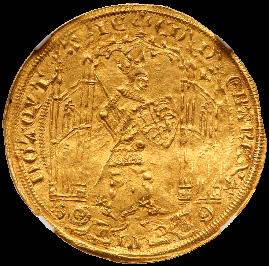

Of special mention the Anglo-Gallic includes the finest graded La Rochelle Mint Edward III Guyennois D'Or NGC graded at MS63 estimate $15,000 (above) and the finest graded Le Mans Mint Henry VI Salut D'Or NGC graded at MS64 estimate $7,500.
The silver Taler collection consists of pieces from Austria, Bohemia, Germany, Hungary, Transylvania and Poland, some doubles and fractional and numbers to some 77 lots. The British coin section contains a number of outstanding pieces ranging from the early Anglo-Saxon period right through till the more modern decimal gold coins of Queen Elizabeth II.
The William Oldknow Collection heads the section with a number of the Anglo-Saxon Kings represented; a highlight amongst which is the Alfred the Great portrait Penny with Londinia monogram on the reverse.

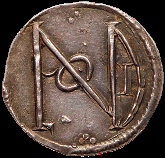
The variety a firm favourite amongst collectors of the series, this piece has been NGC graded MS63+ and is currently top of the NGC population, conservatively estimated at $5,000.
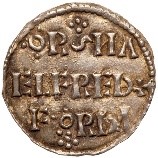
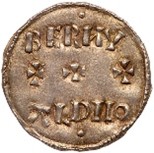
However, one of the highest graded pieces in the Anglo-Saxon section is another coin of Alfred the Great but this is a non-portrait Orsnaforda Viking imitation of one of his issues, NGC photo certificated at MS64 shown above and estimated at a mere $1,500.

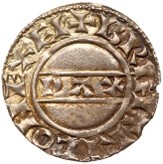
A number of the Saxon pieces are graded in the MS range, and another rare highlight shown above, is the Harold II Penny which is the rare variation without the sceptre before the bust, from the Exeter Mint graded by NGC at AU58 at a $3,500 estimate.
The Oldknow Collection progresses through the Norman Kings into the Medieval starting with an MS64 NGC graded PAXS Penny of William the Conqueror, Gloucester Mint, estimated at a conservative $1,000. The collection ends on a couple of rare provincial Halfcrowns of the Stuart King Charles I for the mints of Worcester and Shrewsbury both NGC graded AU58.

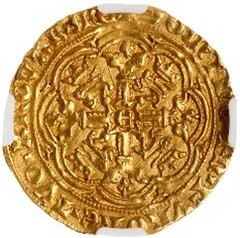
The other headline part of the British section are the slabbed and graded gold coins, starting with the finest NGC graded Half Noble of King Edward III shown above, which at the time of writing is actually the finest graded Half-Noble for the whole life of the denomination at MS65 estimated at $7,500.

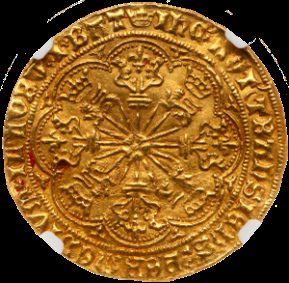
This is followed by a number of high grade Nobles and Ryals all in the MS levels, including what is currently the highest graded Ryal of King Edward IV, London issue in an NGC MS63 holder. This coin is estimated at a conservative $7,500 and is shown above.
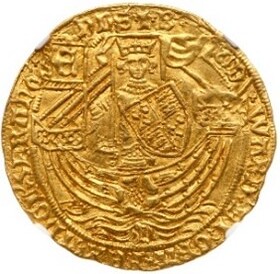
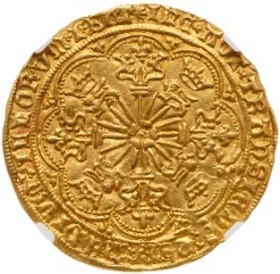
Interestingly there are also Ryals of this monarch on offer from the extremely rare Coventry Mint with C in waves below the ship estimated at $12,500, as well as Bristol at $7,500 with B in waves, which is the highest graded of the mint; and the extremely rare Norwich Mint at $19,500 shown above with n in the waves.

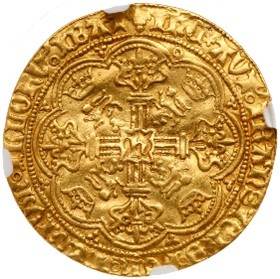
The only mint not present for a gold Ryal is York, a mint which in this sale is instead represented in gold by a Noble of Edward's predecessor King Henry VI estimated at $12,500 with the lis mint mark at the stern of the ship shown above.
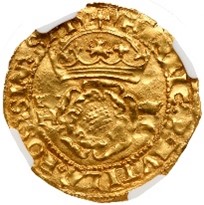

Moving into the Tudors there is the current highest graded gold Crown of King Henry VIII, one of his posthumous issued NGC graded MS63 estimated at $5,000 show above, followed by gold Sovereigns of Elizabeth I and the Stuart King James I.

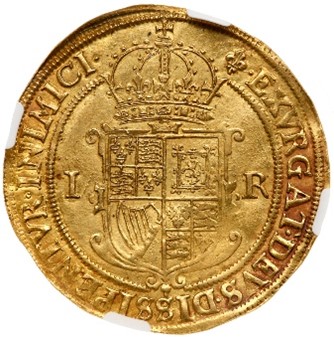
The latter coin shown above, being currently the finest graded Sovereign of King James in NGC AU58 estimated at $40,000.
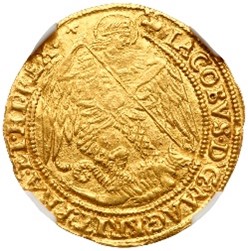

The finest James I coin in the sale though is an example of the very rare fine gold Angel mint mark trefoil which has been NGC graded MS63 and is an unpierced example. Highly unusual as such coins were intended to be holed and worn by the recipient as a healing amulet having been given out by the King himself to represent his Royal touch. Therefore, examples without a hole are most unusual, and to find one graded so high is a real rarity, with an estimate of $12,500 shown above.
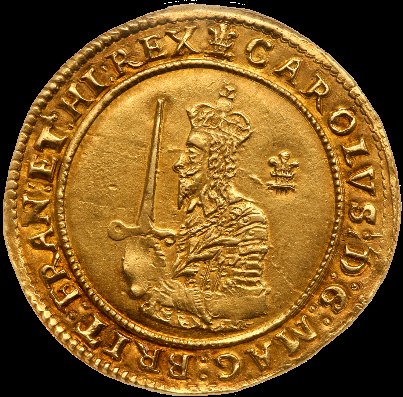

Moving into the reign of Charles I we have an example of the Briot issue Half-Unite or Double- Crown, currently top of the NGC population as AU58 and estimated at $22,500, followed by the largest hammered gold coin in the sale, an example of the spectacular Charles I gold Triple Unite from the first year of the Oxford Mint 1642, NGC graded AU58, this coin shown above is estimated at $100,000.
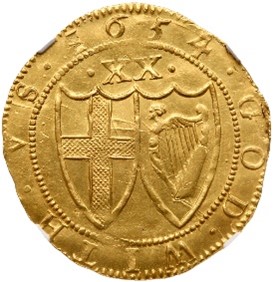
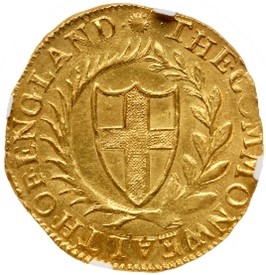
A companion Oxford Unite dated 1643 is then followed by hammered gold coins of the Commonwealth period which includes the current highest graded 1654 gold Unite in NGC grade MS63 estimated at $17,500 shown above.
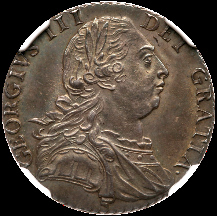
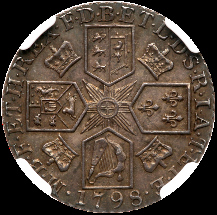
There then follows a group of milled silver and gold all in superlative grades of varying denominations. Highlights include high grade coins of the Hanoverian Georges, including an example of the very rare "Dorrien and Magens" Shilling dated 1798 of which only a small number survive. The example in this sale shown above, NGC grades at MS62 and there is an interesting story explained in detail in the catalogue as to the circumstances of the issue and why so few survive, estimate is $35,000.


There are a number of higher-grade pattern and proof coins of George III from things as diverse as a 1770 Proof Halfpenny in PCGS PF65 at $3,500 to a pattern Wreath Dollar of 5/6d in silver dated 1811 NGC graded PF60 at $10,000 shown above. This silver "dollar" coin appears to be the only example available to collectors of the six berry wreath obverse, with the scant few others known all housed in museum collections.
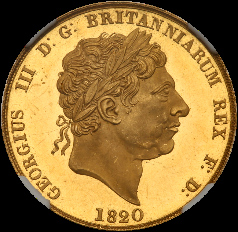
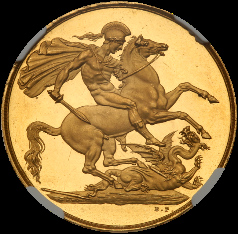
The highlight and front cover coin of the catalogue is the George III Pattern gold Two Pounds dated 1820 shown above, of which only sixty examples were struck, as the dies for the coins were literally still in preparation at the time George III passed away. The example offered here has been graded by NGC as PF63 ultra cameo and is estimated at $60,000.
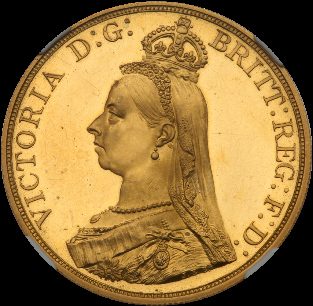
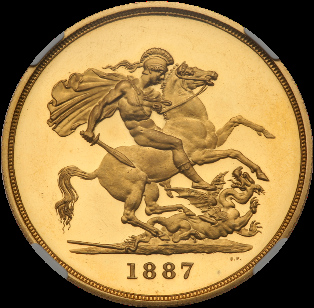
Moving onward into the reign of Queen Victoria the largest gold pieces on offer are a Golden Jubilee Proof Five Pounds of 1887 graded by NGC as PF63 Cameo with the Jubilee bust by Boehm, it is estimated at $25,000 and shown above.
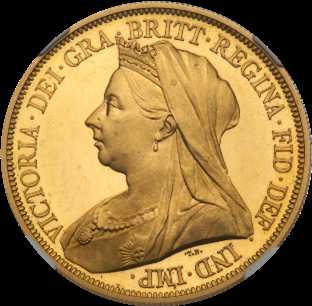

Following on from this is the next Five Pound Proof issued in this reign for 1893 with the older veiled head of Victoria by Thomas Brock, this coin is graded by NGC as PF61+ Ultra Cameo, show above and estimated at $15,000. There is also a companion proof Two Pounds of 1893 graded NGC PF63 Cameo estimated at $7,500.
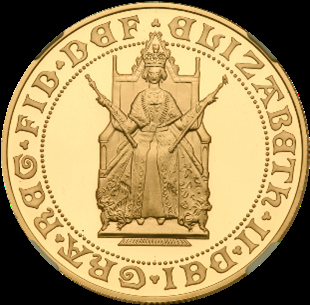
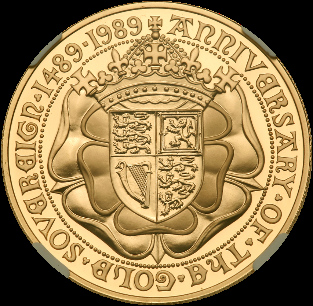
Moving onward other pattern and proof coins in gold and silver are on offer from the 20th Century period, with a good gold decimal section with Five Pound pieces of varying commemorations. One of the more highly sought after pieces, is the 500th anniversary of the Sovereign gold Five Pounds shown above, graded by NGC at PF70 Ultra Cameo and estimated at $7,500.
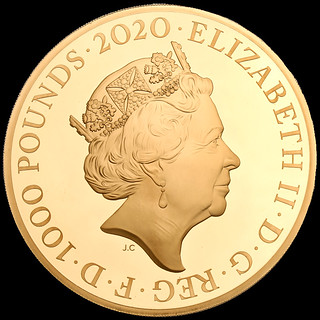
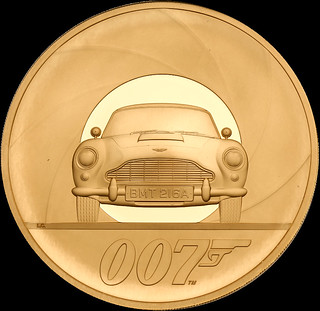
The modern section also contains the two largest coins in the sale in the form of two different kilo coins in gold of £1,000 face value, one is celebrating the Chinese lunar year of the dog for 2018 estimated at $70,000; and the other shown above celebrates the iconic literary character and multi-film franchise of James Bond estimated at the same value.
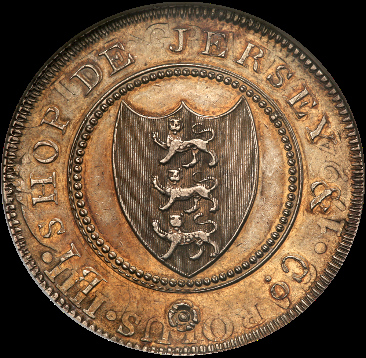
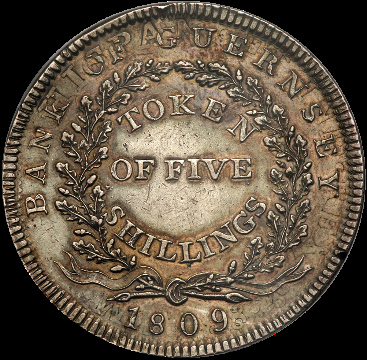
The British section ends on the decimal coins but one other coin of special note is for what is today the special territory of Guernsey, one of the Channel Islands off the UK. The coin shown above is the only pre-decimal period Crown of Five Shillings ever issued on the island by the bank of Bishop De Jersey dated 1809 and struck over a Spanish Empire dollar of Mexico City. Graded by NGC as AU58 it is estimated at $15,000 and is a major rarity of the Channel Island series.
The printed New York sale catalogues are hot off the press now and the auction partners of the USA and Europe are willing and able to help answer any enquiries.
For more information on the sale, see:
http://www.thenewyorksale.com/
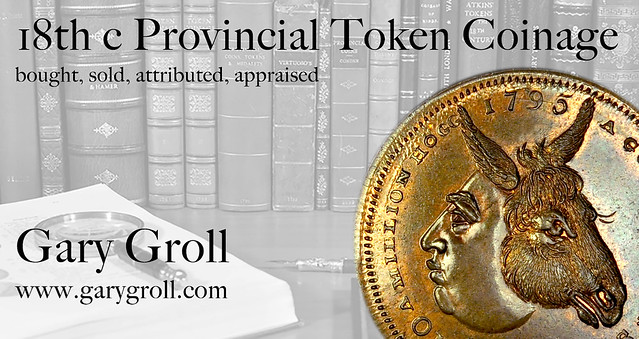
CLASSICAL NUMISMATIC GROUP TRITON XXIV SALE
Here is the press release for Classical Numismatic Group's January 2021 sale, Triton XXIV. Some amazing coins. -Editor
A Live Online Sale
Closing Tuesday & Wednesday, 19-20 January 2021
Classical Numismatic Group, LLC is proud to present Triton XXIV, a Live Online Sale closing Tuesday & Wednesday, 19-20 January 2021, from our Lancaster, Pennsylvania office. This sale offers 1461 lots with a presale estimate of $6.5 million.
Triton XXIV, CNG's flagship auction, features Greek, Celtic, Oriental Greek, Central Asian, Roman Provincial, Roman Republican and Imperatorial, and Roman Imperial coinage. Additionally, there are featured selections of Byzantine, Early Medieval and Islamic, World coinage and medals, and British coinage and medals.
Triton XXIV is highlighted by a number of collections and individual rarities, which make up the majority of coins on offer:
- A Diverse Offering of Coins from the Peter J. Merani Collection, Part I, with a focus on Roman Imperatorial, first century Roman Imperial, and Papal medals. (The Merani Collection is offered in a separate catalog and features many important rarities in affordable condition.)
- Ancient, World, and British Coins from the Lampasas Collection
- Ancient Coins from the William H. Birkinshaw, Grand Haven, Weise, and TAB Collections
- Greek Coins from the Collections of Jonathan P. Rosen and a Northern California Gentleman
- A Stater from the First Gold Issue of Pantikapaion
- A Large Selection of Kyzikos Electrum, featuring 90 Staters from the Rosen & Siren Collections
- A Masterful Tetradrachm of Pixodaros
- A Gold Dinar of the Sasanian King Ohrmazd (Hormizd) I
- Roman Gold Coins from the Collection of Professor David R. Beatty, C.M., O.B.E.
- Extremely Rare Portrait Aurei of Brutus, Antony & Octavia, and Octavian & Divus Julius Caesar
- Coins of Tiberius from the David Feinstein Collection
- Iconic Umayyad Year 77 Dinar
- An Impressive and Extremely Rare Danzig 10 Dukaty of Jan II Kazimierz
- Further Selections from the Princeps Collection of Transylvanian Coinage, featuring a Gold 3 Dukát of József II from the Gyulafehérvár (Karlsburg / Alba Iulia) mint
- British Coins from the Arthur M. Fitts III Collection, featuring Charles I and the English Civil War
- A Classic English Rarity – the Mary Ship Ryal from the Tower Mint
Catalogs for Triton XXIV will have been mailed to CNG's active mailing list by December 5th, 2020, and bidding will open on their website by December 15th. Some of the individual highlights from Triton XXIV are:
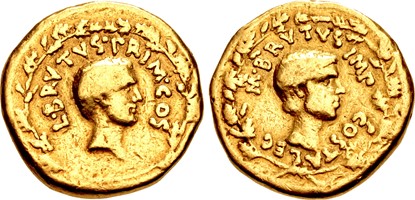
Lot 54 – The Republicans. Brutus.
Late summer-autumn 42 BC. AV Aureus (19mm, 8.01 g, 12h). Military mint traveling with Brutus and Cassius in western Asia Minor or northern Greece. Bare head of L. Junius Brutus right; L • BRVTVS • PRIM • COS around; all within corona civica (oak-wreath) / Bare head of M. Junius Brutus right; M • BRVTVS IMP around above; COSTA LEG around below; all within corona civica (oak-wreath). Crawford 506/1; CRI 208; Calicó 60 = Biaggi 41 (same dies); Sydenham 1295; BMCRR East 57-8; Woytek Arma et Nummi, 202; Bahrfeldt 64.6 = Cohen 16 = RBW 1777 (this coin). Some light marks and scratches. Fine. Exceedingly rare, one of nine known, and perhaps one of only three in private hands. The other possible private examples being the Biaggi and the Ponton d'Amécourt specimens. Also, it should be noted that all published examples of this rarity are struck from a single obverse and reverse die. Only this coin in CoinArchives–the only specimen to sell in public auction over the last twenty-plus years.
Estimated at $150,000
From the Peter J. Merani Collection. Ex Property of an European Nobleman (Numismatica Ars Classica 24, 5 December 2002), lot 6 (hammer 65,000 CHF); RBW Collection (Triton III, 30 November 1999), lot 844; Münzen und Medaillen AG 77 (18 September 1992), lot 141; Duplicate from the Bibliothèque Nationale, purchased in 1844 from the Paris dealers Charles-Louis Rollin (1777-1853) and his son Claude-Camille Rollin (1813-1883).
In his The History and Coinage of the Roman Imperators 49-27 BC, David R. Sear writes in reference to this coin: "We now reach the final and unquestionably the most remarkable phase of Brutus' coinage." Sear continues, "On this beautiful aureus his portrait is accompanied by that of his renowned ancestor Lucius Junius Brutus, first consul of the Republic. Both heads are encircled by the corona civica of oak traditionally awarded to those who had displayed their patriotism by saving the lives of comrades in the heat of battle or by rescuing the Republic itself at times of great peril."
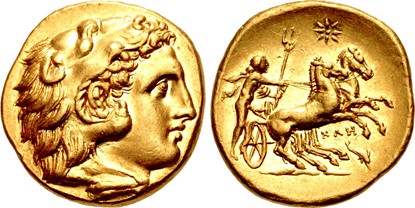
Lot 336 – CALABRIA, Tarentum.
Circa 281-276 BC. AV Stater (18.5mm, 8.53 g, 12h). Youthful head of Herakles right, wearing lion skin / Taras(?), holding reins in right hand, trident in left, driving fast biga right; star above; below horses, K?H above dolphin downward. Fischer-Bossert G20 (V17/R20); Vlasto, Or Type O 1 [a]; Vlasto 18 (same dies); HN Italy 955; Hirsch 85 (same dies); McClean 600 (same dies). Lustrous. Superb EF. Well centered and struck.
Estimated at $50,000
There is a divergence of opinion concerning the dating of this attractive gold issue of Tarentum, which displays a youthful head of Herakles resembling the Macedonian issues of Alexander III the Great and a reverse depicting a nude male youth holding a trident, probably Taras / Phalanthos, driving a biga. The lack of a civic ethnic and the control letters K?H on the reverse led N. K. Rutter, in Historia Nummorum Italy, and Oliver Hoover in Handbook of Greek Coins Vol. I, to place their minting during the expedition of the Spartan commander Kleonymos, who crossed to Italy at Tarentum's invitation circa 302 BC, to pay his large mercenary army. Wolfgang Fischer-Bossert, citing the support of S. Garraffo and G.K. Jenkins, places the issue during the more famous Italian expedition of Pyrrhos of Epeiros, circa 281-276 BC. The type's great rarity means there is little in the way of hoard evidence to support either side. However, their similarity to Pyrrhic bronze issues in Sicily and Pyrrhos's strong desire to emulate Alexander the Great argue for the latter dating, in which case the K?H refers to a magistrate rather than to Kleonymos.
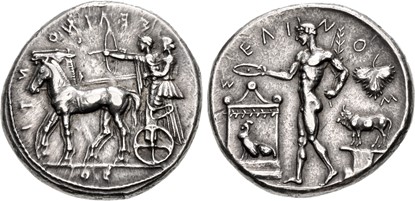
Lot 386 – SICILY, Selinos.
Circa 455-409 BC. AR Tetradrachm (27.5mm, 17.48 g, 9h). Artemis, holding reins in both hands, driving quadriga left; beside her, Apollo standing left, drawing bow; retrograde SE?INO-N-TI-OS around / River-god Selinos, nude, standing left, holding in right hand a phiale over altar to left, cradling in left arm a palm branch; before altar, cock standing left; to right, selinon leaf above bull standing left on basis; S-E?I-N-O-S around above. Schwabacher 3b (Q1/S3) = Rizzo pls. XXXI, 9 and XXXII, 2-3 = Gillet 494 = Kunstfreund 101 (this coin); HGC 2, 1220; SNG Lloyd 1221 = AGC 377 (same dies); Hirsch 467 = Kraay & Hirmer 186 (same obv. die). Attractive light toning. EF. A masterpiece of classical style.
Estimated at $50,000
Ex Baron Lorne Thyssen-Bornemisza & Dr. Thomas S. Kaplan Joint Collection (Numismatica Genevensis SA IX, 14 December 2015), lot 14; Star Collection (Numismatica Ars Classica 48, 21 October 2008), lot 39; Leu 76 [Exceptional Private Collection] (27 October 1999), lot 49; Charles Gillet [as Kunstfreund] Collection (Leu & Münzen und Medaillen AG, 28 May 1974), lot 101; Royal Collection in Naples, acquired in the 19th century or earlier, deaccessioned during the 1930s.
Situated on the southwest coast of Sicily at the mouth of the Selinunte River, Selinos was founded by colonists from Megara Hyblaia, a town on the eastern coast of the island. The coinage of Selinos regularly featured a wild parsley leaf, since the ancient Greek name for this,

Lot 717 – SATRAPS of CARIA. Pixodaros.
Circa 341/0-336/5 BC. AR Tetradrachm (24mm, 15.25 g, 12h). Halikarnassos mint. Struck circa 341/0 BC. Head of Apollo facing slightly right, wearing laurel wreath, drapery at neck / Zeus Labraundos standing right; ?I?O?APOY to right. Pixodarus 7–8 (unlisted dies); Konuk, Identities 29; Babelon, Perses –; HN Online 1.1 (this coin, illustrated); SNG Keckman –; SNG von Aulock 8047; SNG Copenhagen –; BMC –; Traité –. Beautiful deep iridescent tone. Superb EF. A masterpiece of late Classical engraving. Very rare denomination, and the finest known.
Estimated at $50,000
Ex Baron Lorne Thyssen-Bornemisza & Dr. Thomas S. Kaplan Joint Collection (Numismatica Genevensis SA IX, 14 December 2015), lot 61; Triton XII (6 January 2009), lot 325 and front cover coin.
As part of the Achaemenid Empire, Caria in the fourth century BC was under the rule of a family of semi-independent satraps known as the Hekatomnids after the dynasty's founder, Hekatomnos. Born in Mylasa, Hekatomnos was appointed satrap of Caria by Artaxerxes II after the fall of Tissaphernes in 392/1 BC and was later given control of Miletos in 386 BC. Interested in Hellenic culture (and possibly hedging his diplomatic bets), Hekatomnos sent his youngest son, Pixodaros, to Athens as part of a deputation; his older son, Maussolos, was bound by xenia, or guest friendship, with Agesilaus, king of Sparta. Hekatomnos died in 377/6 BC and was succeeded by Maussolos. When Maussolos died in 353/2 BC, his sister-wife, Artemisia, succeeded him. Her rule, however, was short-lived, and in 351/0 BC power passed to Hidrieus, Artemisia's brother and the second son of Hekatomnos. Hidrieus' reign was also relatively short-lived, as he contracted a disease and died in 344/3 BC. Rule then passed to another sister, Ada.
In 341/0 BC, Pixodarus, the youngest son of Hekatomnos, overthrew his sister, Ada, possibly aided by the external support of the Persian commander of Asia Minor, Mentor of Rhodes. This usurpation did little to endear the new satrap to Artaxerxes III, who had recently approved Ada's appointment following the death of her husband, Hidrieus. Ada, nevertheless, continued to receive support from the countryside, and still held the city of Alinda. As a result, Caria was thrown into turmoil and hesitated to support Persia following the invasion of the Macedonians under Parmenion in 336 BC. This non-support of their nominal overlord was also compounded by the secret negotiations of alliance that Pixodaros had been conducting with the Macedonian king. In 337 BC, Pixodaros attempted a marriage between one of his daughters and the future Philip III Arridaios. Believing himself overlooked, Philip's elder son, Alexander III, sent a private embassy to Halikarnassos, asking for the hand of the same princess. When word of this reached Philip II, he cancelled the Macedonian-Carian alliance. Pixodaros died of natural causes in 336/5 BC, and was succeeded by Orontobates, an otherwise unknown Persian, who apparently married the princess Pixodarus had attempted to betroth to Philip III. The fate of Orontobates is uncertain, but after Caria was conquered by Alexander III in 332 BC, the Macedonian king made diplomatic overtures to Ada, and reappointed her as satrap.
While the didrachms of Pixodaros are fairly common, his tetradrachms are rare, with only a handful known, even following the discovery of the Pixodarus Hoard, which added a mere 18 tetradrachms to the corpus. While many of these coins exhibit the same insipid style that became prevalent in the coins of Hidrieus, the present example displays a style of rare exuberance and vitality, both in the countenance of the facing head of Apollo on the obverse and in the stoic figure of Zeus Labraundos on the reverse. As this coin does not have the small E on the reverse, between the leg of Zeus and his scepter, which was apparently a carry-over from the coins of Hidrieus, this suggests that these dies were engraved at a latter period during Pixodaros' reign, and evidently by a new, highly talented artist. This later date is also suggested by the fact that no examples from these dies were present in the Pixodarus hoard, which is believed to have been deposited near the middle of his reign. The rarity of the tetradrachms also suggests that they were produced at a much smaller scale than the didrachms, and probably were struck for special occasions.

Lot 979 – The Triumvirs. Mark Antony and Octavia.
Summer 38 BC. AV Aureus (20mm, 8.04 g, 12h). Athens mint. Bare head of Mark Antony right; M • ANTONIVS • M • F • M • N • [AVGVR •] IMP • TER around / Head of Octavia right, her hair tied in a knot behind with one long plait arranged as a loop on top of her head; COS • DESIGN • ITER • ET • TER • III • VIR • R • P • C around. Crawford 533/3a; CRI 268; Bahrfeldt 90 (Pl. IX, no. 6 – same dies); Calicó 111 = Biaggi 67; Sydenham 1200; BMCRR East 144; Cohen 1; RBW –. Some light marks and scratches. VF. Exceedingly rare, Bahrfeldt listed five specimens (Berlin, Paris, and 2 specimens in London), with one in private hands in 1923 (the Trau specimen, which share the same dies with the present coin), and the NAC cataloguer in their auction 46 stated "only seven specimens known, of which only three are in private hands." In NAC 70 (May 2013), another specimen was sold (lot 194), which increased the count to eight specimens known, four in private hands. Three specimens appear in CoinArchives, including the two previous appearances for this coin, the NAC 70 specimen (realized 100,000 CHF), and another example that appeared in NAC 111 (September 2018, lot 153, realized 27,000 CHF but double struck on the reverse and also off center).
Estimated at $75,000
From the collection of Professor David R. Beatty, C.M., O.B.E. Ex William H. Williams Collection (Numismatica Ars Classica 46, 2 April 2008), lot 456 (hammer 75,000 CHF); Numismatica Ars Classica 33 (5 April 2006), lot 392 (hammer 120,000 CHF).
Shortly after the Battle of Philippi in 42 BC, cracks began to appear in the Second Triumvirate. Antony's affair with Cleopatra, queen of Egypt, and his designs on Rome's eastern holdings, prompted Octavian to formulate a binding agreement that would buy him time. At Brundisium a pact was signed, bringing about reconciliation and some semblance of peace. As a condition of this reconciliation, Antony was married to Octavian's widowed sister, Octavia. She stayed with him in Athens while he continued to prepare for a war against Parthia, and where, in 39 BC, he was associated with the "New Dionysus". In 37 BC, she helped negotiate the Pact of Tarentum, which renewed the triumvirate until 33 BC. Antony, by this time, however, had renewed his affair with Cleopatra. He remained in the East, where he married the queen, and subsequently fathered several children. In 32 BC, as a renewal of civil war became imminent, Antony divorced Octavia. In the aftermath of Antony's death, Octavia, known for her loyalty and nobility, brought Antony's surviving children to Rome to live with her.
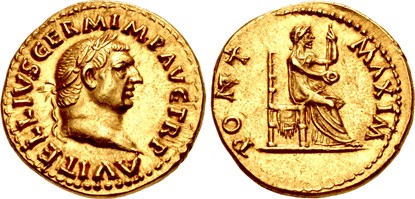
Lot 1063 – Vitellius.
AD 69. AV Aureus (20mm, 7.28 g, 6h). Rome mint. Struck circa late April-20 December. A VITELLIVS GERM IMP AVG TR P, laureate head right / PONT M?XIM, Vesta, veiled and draped, seated right on throne, holding patera in extended right hand, left hand holding short scepter propped on leg. RIC I 106; Calicó 571; BMCRE 33; BN 70; Biaggi 282. A small scratch skillfully repaired in the obverse field. Superb EF. Wonderful portrait.
Estimated at $30,000
Ex Künker 270 (2 October 2015), lot 8642 (hammer €105,000); Lanz 145 (with Numismatica Bernardi, 5 January 2009), lot 69; Lanz 135 (21 May 2007), lot 569 (before scratch removed).

Lot 1140 – Regalianus. Usurper, AD 260. AR Antoninianus (19.5mm, 2.16 g, 3h). Carnuntum mint. IMP C P C REG?LI?NVS ?VG, radiate and draped bust right / ORIENS ?VGG, Sol standing left, raising right hand and holding whip in left. RIC V 7; MIR 43, 1713f (same dies as illustration); RSC 4a. Toned. VF for type. Reverse overstruck on a Denarius with Victory advancing left, holding wreath and palm frond. Very rare and with the complete name of the usurper. Estimated at $7500
Ex Roma XVII (28 March 2019), lot 787.
Following the capture of Valerian I by the Persians, a number of usurpations occurred throughout the empire. In Illyricum, one of Valerian's generals, Cornelius Publius Caius Regalianus, seized power, but was killed by his own troops after a very short reign. All of Regalianus' coinage has been attributed to a mint in Carnuntum (on the Danube between modern Hainburg in Austria and Bratislava in Slovakia). It was obviously struck in great haste as evidenced by the relatively crude style and the fact that his known coins are all overstruck on other coins.
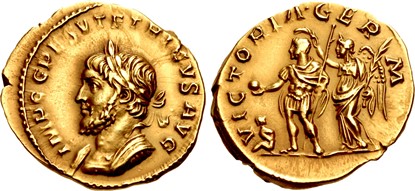
Lot 1141 – Tetricus I.
Romano-Gallic Emperor, AD 271-274. AV Aureus (19mm, 4.45 g, 6h). "Victoria Germanica" issue. Mint City II (Cologne). 1st emission, December AD 271. IMP C G P ESV TETRICVS AVG, laureate and cuirassed bust left / VICTORIA • GER M, Tetricus standing left, holding globe in right hand and scepter in left, being crowned by Victory, holding wreath in right hand and palm frond in left; to left at feet of Tetricus, bound captive seated left, head right. RIC V 38 var. (bust type); Schulte 2 (dies 3/- [unlisted rev. die]); Sondermann 1.2 = D. Hollard, "Un aureus inédit de Tétricus Ier découvert en Afghanistan," BSFN 58.10 (December 2003), pp. 225-9 = L. Dussubieux and B. Gratuze, "Nature et origine des objets en verre retrouvés à Begram et à Bara," De l'Indus à l'Oxus: Archéologie de l'Asie centrale (2003), 285 (this coin); Calicó –; Biaggi –; Jameson –; Mazzini –. Pleasant river patina. EF. Rare.
Estimated at $30,000
Ex collection of a Retired Banker (Numismatica Ars Classica 117, 1 October 2019), lot 336 (hammer CHF 50,000); Numismatica Ars Classica 111 (24 September 2018), lot 204; Classical Numismatic Group 87 (18 May 2011), lot 1122.
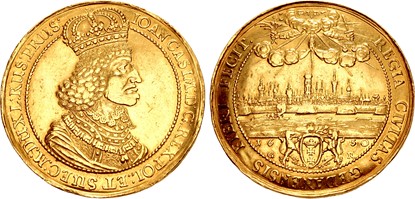
Lot 1318 – POLAND, Monarchy. Jan II Kazimierz.
1648-1668. AV 10 Dukaty (47.5mm, 34.81 g, 12h). Gdansk (Danzig) mint; Gerard Rogge, mintmaster. Dated 1650 G R. IOAN CASIM : D : G : REX POL ET SUEC : M : DUX : L : RUS : PRUS :, crowned, armored, and collared bust right, wearing ruff / REGIA CIVITAS GEDANENSIS FIERI FECIT., view of city of Gdansk (Danzig) with scenes of immediate countryside; above, radiate tetragrammaton with four arms emerging from clouds: arm to left holding olive branch; arm to right holding sword and scales; below, two arms with hands clasped together in prayer; in exergue, royal coat-of-arms with leonine supporters; date and G R (mintmaster's initials) flanking. D&S, Gedanensis, 353; MD D50a; Czapski 1925; Kopicki –; Gumowski –; KM 52; cf. Friedberg 26 (unlisted date). EF, minor scratches and edge marks. Extremely Rare.
Estimated at $100,000
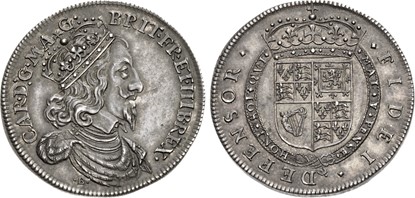
Lot 1404 – STUART. Charles I.
1625-1649. Pattern AR Shilling (29mm, 9.15 g, 6h). By Nicholas Briot. MI 375/271; Brooker 1261 (this coin); North 2664. A masterpiece by Briot. Richly toned with underlying luster. Superb EF. Of the highest rarity and with an exceptional provenance.
Estimated at $20,000
Ex Martin Hughes Collection (Spink 139, 16 November 1999), lot 153; H. Selig Collection (Spink 70, 31 May 1989), lot 223; R.S. James Collection (Spink 31, 12 May 1983), lot 235; John G. Brooker Collection, 1115; Helen l. Farquhar Collection (Glendining's, 25 April 1955), lot 150; T. Bliss Collection (Sotheby, Wilkinson, & Hodge, 22 March 1916), lot 401; H. Montagu Collection (Sotheby, Wilkinson, & Hodge, 11 November 1896), lot 399; W. Brice Collection (purchased by H. Montagu, 1887); J.B. Bergne Collection (Sotheby, Wilkinson, & Hodge, 20 May 1873), lot 851; Lt.-Col. W. Durrant Collection (Sotheby & Co., 19 April 1847), lot 682; Duke of Devonshire (Christie & Manson, 26 March 1844), lot 135.
Printed catalogs for Triton XXIV will be available after December 5th, 2020. To order the catalog, please call our U.S. office at +1 (717) 390-9194. Catalogs have been mailed to customers on CNG's active mailing list. The sale can be viewed online at auctions.cngcoins.com, sixbid.com, and numisbids.com.
In addition to Triton XXIV, CNG will also feature over 1000 lots from many of the same collections listed above in their Electronic Auction 484, closing one week later on Wednesday, 27 January 2021, from 10AM ET (U.S.). Bidding for CNG Electronic Auction 484 will begin on 6 January 2021.
CNG is currently accepting consignments for future auctions sales. Please contact the firm for further details and consignment deadlines.
For further details and any additional information, please contact CNG, LLC at:
Classical Numismatic Group, LLC
P.O. Box 479
Lancaster, PA 17608-0479
Telephone: (717) 390-9194
Fax: (717) 390-9978
Email:
cng@cngcoins.com

CANAAN BRONZE AGE SILVER DEBASEMENT
Dick Hanscom passed along this Live Science article about the chemical composition of hoards of Bronze Age silver found a around Israel. Thanks. -Editor
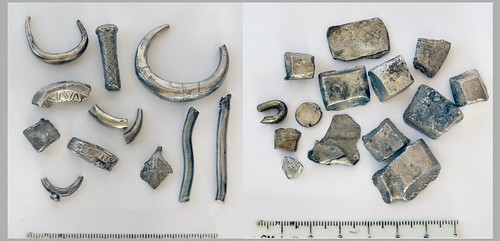
A shortage of silver caused by the collapse of leading Bronze Age civilizations around the eastern Mediterranean about 1200 B.C. resulted in the original "dirty money" — several hundreds of years before coins had been invented.
The ancient counterfeiting was revealed by archaeologist Tzilla Eshel, then a doctoral student at the University of Haifa, who studied the chemical composition of 35 buried hoards of Bronze Age silver found at archaeological sites around Israel.
In eight of the hoards — dating from the time of the "Late Bronze Age collapse," when the region's most powerful kingdoms suffered often-violent demises — had been deliberately debased, with cheaper alloys of copper substituted for much of the silver and an outer surface that looked like pure silver.
Because the hoards date back to the when the region, then known as Canaan, was ruled by ancient Egypt, the researchers think this deception originated with the Egyptian rulers, possibly to disguise the fact that their supplies of the precious silver widely used as currency were failing.
Canaan had no silver ores of its own, and the precious metal had to be imported. But the silver trade appears to have quickly come to an end when the nearby kingdoms started collapsing between about 1200 and 1150 B.C.
"There was a shortage of silver, probably related to the Late Bronze Age collapse," Eshel told Live Science. "[Counterfeiting] continued after the Egyptians left Canaan, but they were probably the ones who initiated it."
To read the complete article, see:
Ancient Egyptian hoard of counterfeit 'dirty money' unearthed
(https://www.livescience.com/ancient-egyptian-hoard-counterfeit-dirty-money.html)
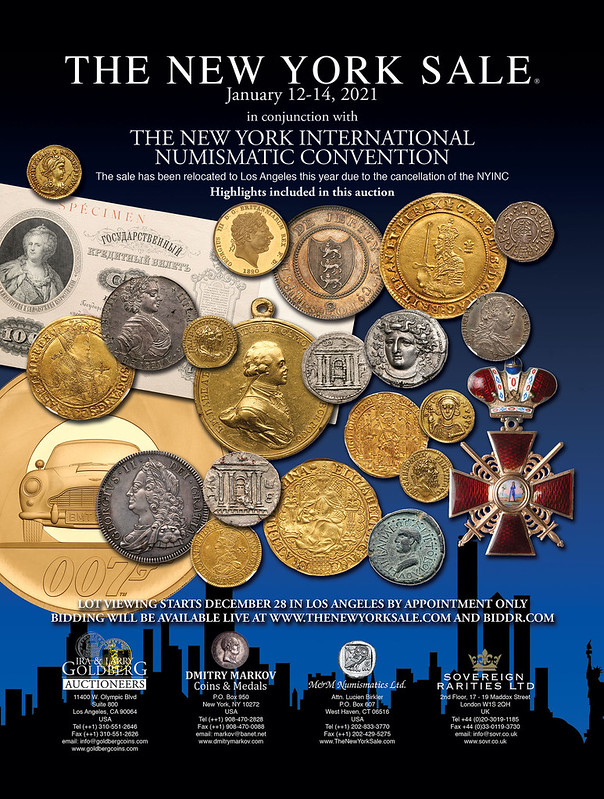
THE COINAGE OF RHEGIUM
On November 30, 2020 Mike Markowitz published a new CoinWeek Ancient Coin Series article on the coinage of Rhegium. Here's an excerpt - be sure to see the complete article online. -Editor
FOR CENTURIES, THE narrow Strait of Messina that separates Sicily from the toe of Italy has been a crossroads of history.
The town of Rhegium (or Rhegion, today Reggio di Calabria) located on the Italian side of the Strait, was one of the first Greek cities in Italy, founded by colonists from Chalcis in the eighth century BCE. Cities of this region competed vigorously during the fifth and fourth centuries BCE to create coins of enduring classical beauty, and the silver tetradrachms of Rhegium stand as some of the finest – and most highly valued – products of the ancient engraver's art.
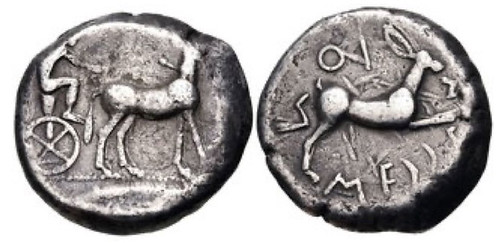
Messana. 478-476 BCE. AR Tetradrachm (24mm, 16.96 g, 5h). Charioteer driving biga of mules right; leaf in exergue / Hare springing right. Caltabiano B1 ('Barbarous'; same dies as illustration); SNG ANS –; SNG Tübingen 605 (same dies); Weber 1412 (same dies); HGC 2, 779. Near EF, toned.Estimate: $200.
In 494 BCE a man named Anaxilas became tyrant of Rhegium. In ancient Greek, a tyrannos was a ruler that "owed his power neither to his royal descent nor to a constitutional appointment and was not bound by any laws (Jones, 236)."
Among his actions, Anaxilas captured the seaport of Zancle on the Sicilian side of the Strait and renamed it Messana (today Messina, Italy). And when his team won the mule cart race in the Olympic games, Anaxilas commemorated this victory on coins issued in both towns that he controlled. The reverse of the coins depicts a leaping hare, supposedly because Anaxilas was proud of having introduced this prolific animal to Sicily for the benefit of hunters. The coins of Messana are considerably more common than those of Rhegium.
To read the complete article, see:
The Coinage of Rhegium
(https://coinweek.com/ancient-coins/the-coinage-of-rhegium/)
READING ROMAN COINS
In October Mike Markowitz published a very useful CoinWeek article on reading inscriptions and dates on ancient Greek coins. This week he published a companion article on ancient Roman coins. Here's an excerpt - see the complete article online. -Editor

ANCIENT ROMANS WERE practical-minded people; they didn't like wasted effort. Every letter on an ancient Roman coin die was painstakingly engraved by hand, so inscriptions on Roman coins are often heavily abbreviated. Generations of classical scholars have toiled to unravel the meaning of these cryptic abbreviations, so we can usually understand what the coins are trying to tell us.
Still, modern collectors are accustomed to a lot of specific information on a coin: the name of the country or issuing authority, the coin's denomination, the date of issue, the mintmark, and perhaps a motto (such as E PLURIBUS UNUM – "out of many, one" – on American coins).
Such information is usually missing on ancient coins. And, to complicate things, Roman inscriptions were usually written without spaces between words.
This article will consider a dozen coins issued across the long span of Roman history, to sample the enormous diversity of inscriptions.
ROMANO
The Latin alphabet is much like ours. Romans wrote the letter "U" as V. Some modern letters are missing ("J", "W"), while others ("K", "Y", "Z") appear mainly in words borrowed from Greek. All educated Romans could read Greek.
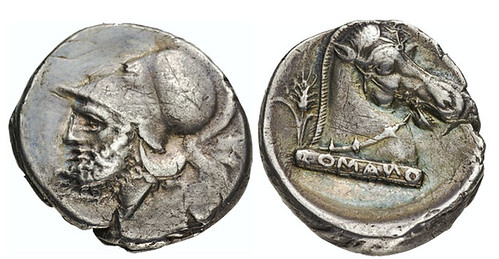
Anonymous. Circa 300/280-276 BCE. AR Didrachm (21mm, 7.12 g, 2h). Uncertain (Neapolis?) mint. Helmeted head of Mars left; oak spray to right / Horse's head right, wearing a bridle, on the base is inscribed ROMANO; stalk of grain to left. Crawford 13/1; Burnett 18 (Oc/R12); Sydenham 1; RSC 4. Classical Numismatic Group > Auction 112 11 September 2019 Lot: 465. Realized: 5,000 USD
The Romans also borrowed the idea of coinage from their neighbors, the Greek cities of southern Italy. Like many ancient Greek coins, one of the earliest Roman silver coins bears a single word, ROMANO, on a raised tablet below a horse head on the reverse, abbreviating the Latin ROMANORUM (literally, "of the Romans"). The "N" in the inscription is backward, suggesting that the engraver might have been unfamiliar with letters. The obverse shows a helmeted head of the war god, Mars.
This coin, a didrachm of about seven grams, dates from about 300-276 BCE. It was possibly struck at Neapolis (modern Naples). It brought $5,000 USD in a recent US auction. On many examples of this type, the word ROMANO is nearly worn off.
Reading the Romans
The standard reference for Roman coin inscriptions is A Dictionary of Roman Coins by Seth Stevenson (1784-1853), a monumental work of Victorian-era scholarship. Stevenson died before it could be completed, and the massive 929-page book was finally published in 1889 (reprinted in 1964); a searchable digital version is available online. Klawans (1995) has a detailed chapter on reading and understanding Roman coins. An inexpensive Latin-English dictionary, such as Traupman (2007), is a handy accessory for any serious collector of Roman coins.
There are also some excellent online resources for researching ancient Roman coin inscriptions–these include CoinArchives, ACSearch, Wildwinds, and OCRE. We hope to explore these, and others, in a future article.
To read the complete article, see:
Reading Ancient Roman Coins
(https://coinweek.com/ancient-coins/reading-ancient-roman-coins/)

BACKYARD TUDOR GOLD COIN HOARD FIND
Mark B. Holton passed along an article from The Guardian about a family's interesting backyard discovery of a valuable hoard of medieval gold and silver coins. Thanks! Mark writes: "Imagine, finding all those gold coins in the garden. Darn, all I find when I dig in my garden are weeds!" -Editor
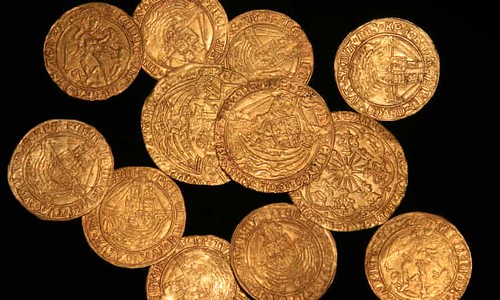
An important hoard of Tudor coins – some of which shine light on the marriage history of Henry VIII – has been found by a somewhat startled family weeding their garden.
The British Museum revealed details on Wednesday of discoveries registered to its Portable Antiquities Scheme (PAS), the majority of which are made by the nation's army of metal-detecting enthusiasts.
More than 47,000 finds have been recorded with the scheme in 2020, with 6,251 reported during the full lockdown from March to May, when metal detecting was prohibited.
Ian Richardson, the treasure registrar at the museum, said people had obviously been spending more time in their garden, "resulting in completely unexpected archaeological discoveries".
That was certainly the case for the unnamed New Forest family who dug up 63 gold coins and one silver coin dating from the 15th and 16th centuries. "They were out turning up the soil and all of a sudden these coins popped out of the ground … miraculously," said Richardson. "It is quite a shocking find for them and very interesting for us."
Probably hidden in about 1540, they include coins from Henry VIII's reign, which are unusual in that they also, separately, feature the initials of three of his wives – Catherine of Aragon (K), Anne Boleyn (A) and Jane Seymour (I).
Barrie Cook, a curator of medieval and early modern coins at the museum, said putting his wives' initials on gold crowns was "a very strange decision" and, numismatically, very interesting.
The Tudor hoard contains coins from the time of Edward IV through to his grandson Henry VIII, with the bulk being "angels", gold coins that have on their back an image of the archangel Michael killing a dragon as described in the book of Revelation. "That's the workaday gold coin of the late medieval and early modern period," said Cook.
John Naylor, a coin expert from the Ashmolean museum, said the hoard was probably buried by a wealthy merchant or a member of the clergy. "You have this period in the late 1530s and 1540s where you have the Dissolution of the Monasteries and we do know that some churches did try to hide their wealth, hoping they would be able to keep it in the long term. It is an important hoard … You don't get these big gold hoards very often from this period."
Thanks also to David Sundman, Dick Hanscom, Arthur Shippee, David Gladfelter and others who forwarded this report. -Editor
To read the complete articles, see:
Tudor coins dedicated to three of Henry VIII's wives found in family garden
(https://www.theguardian.com/science/2020/dec/09/tudor-coins-dedicated-to-three-of-henry-viiis-wives-found-in-family-garden)
Family find ancient gold hoard while gardening
(https://www.thetimes.co.uk/article/new-forest-garden-coin-discovery-is-latest-in-a-string-of-lockdown-finds-wh0wrg5kw)
Lockdown Gardening in Britain Leads to Archaeological Discoveries
(https://www.nytimes.com/2020/12/09/world/europe/uk-treasure-lockdown-gardening.html)
Gold coins, medieval treasures discovered in British backyards during lockdown
(https://www.msn.com/en-us/news/world/gold-coins-medieval-treasures-discovered-in-british-backyards-during-lockdown/ar-BB1bRkE5?li=BBnbklE)
Gold coin stash from time of Henry VIII found in English garden
(https://www.livescience.com/gold-coin-hoard-english-monarchs.html)

THE COINING HOUSE OF SEGOVIA
The restored Segovia Mint in Segovia, Spain is discussed in this brief recent Atlas Obscura article. -Editor
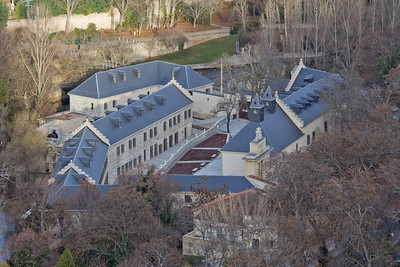
The Segovia Mint
UNTIL THE MID-16TH-CENTURY, EUROPE'S MINTING techniques had not progressed from ancient Greek coinage, which was struck by hand using dies and a hammer. Eventually, this method became ineffective as a large amount of bullion was imported from across the world and the mints had trouble keeping up.
To solve this problem, minting machinery was invented in 1550 based on Leonardo da Vinci's ideas and using hydraulic wheels. It was first adopted by France, followed by England in 1560, Spain, and the Holy Roman Empire. This "milled coinage" was produced in round shapes, unlike the often unevenly-shaped hammered coins. This made them harder to counterfeit.
Spain's machinery-based mint, known as the Coining House of Segovia, was personally funded by King Philip II and completed in 1586. Philip needed the mint to convert silver from the Spanish colonies in South America to coins efficiently, producing the famous "pieces-of-eight" by the tons. This became the first mechanized factory constructed in Spain.
While the Segovia mint was owned by the Royal House, other mints across Spain were run by the National Treasury. They continued hammered coinage for several decades.
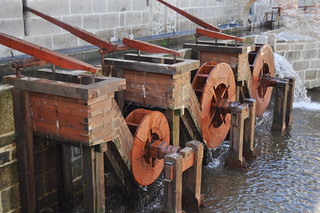 Following Spain's defeat in the Napoleonic Wars, the Coining House fell under the control of Joseph Bonaparte along with the city. The minting in Segovia continued through the restoration of Ferdinand VII, to the deposition of Isabel II.
Following Spain's defeat in the Napoleonic Wars, the Coining House fell under the control of Joseph Bonaparte along with the city. The minting in Segovia continued through the restoration of Ferdinand VII, to the deposition of Isabel II.
In 1878, the mint was sold and renovated into a flour factory, which operated until 1967. The building was then abandoned until it was acquired by the municipality in 1987. Restoration work began three decades later, and it stands today as a museum exhibiting a fascinating collection of coins. It also highlights the history of Segovia and its famous aqueduct.
E-Sylum contributor Gary Beals is a resident of Segovia and he kindly added these notes and images. Thanks! -Editor
The Royal Mint of Segovia is well worth seeing. Someday when we can all travel where we want once again I hope some of your readers can visit Felipe II's big project here. Please give me a call or an e-mail when you come -- any friend of The E-Sylum is a friend of mine. Fellow Californian Glenn Murray, who also lives here in Segovia, was instrumental in restoring the mint back in the 1990s and early 2000s. He is the author of the principal catalog of Segovia coins and other books. Good health to all!

The roller die replicas on display

My 1635 8 reales is on loan to the mint museum. It has a rolling mill error in it.
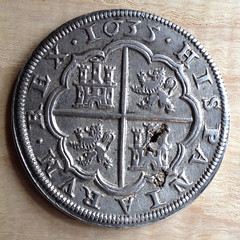 I am concerned that my coin is getting a dark patina because the water-powered mint is down next to the river.
Here is the obverse before it went on display in about 2015.
I am concerned that my coin is getting a dark patina because the water-powered mint is down next to the river.
Here is the obverse before it went on display in about 2015.
To read the complete article, see:
The Coining House
Segovia, Spain
(https://www.atlasobscura.com/places/the-coining-house)
For more information, see:
ASSOCIATION FRIENDS OF THE SEGOVIA MINT
(https://segoviamint.org/Eng-start.htm)
To read earlier E-Sylum articles, see:
FEATURED WEB SITE
(https://www.coinbooks.org/esylum_v02n12a06.html)
MORE ON ANCIENT CLOTHING STYLES
(https://www.coinbooks.org/v21/esylum_v21n04a25.html)

LOUIS ELIASBERG'S BARBER HALF DOLLARS, PART II
Ron Guth's latest blog post is Part II of his investigation into the current whereabouts of the coins once owned by collector Louis Eliasberg. -Editor
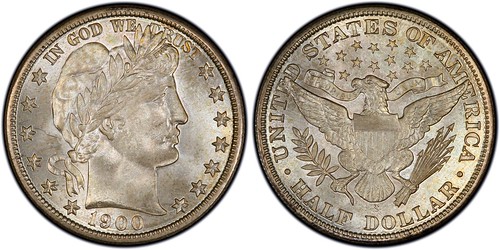
1900-1909
This is the second installment of a three-part series where I identify many of the Barber Half Dollars that were sold in 1997 as part of the Louis Eliasberg, Sr. collection. This installment will look at the dates from 1900 to 1909 and provide updated provenances for as many of the coins as possible. Several of these coins will be coming up for sale as part of the Larry Miller collection by Stack's/Bowers on December 17, 2020. Mr. Miller was in attendance at the April 1997 sale of the Eliasberg Barber Half Dollars conducted by Bowers & Merena, where he purchased quite a few of the coins and placed them in his collection. This cache of Barber Half Dollars from the Eliasberg/Miller collection allowed me to fill in enough holes so that the listing of Eliasberg provenances for this series is almost complete.
Eliasberg obtained most of his Barber Half Dollars from the Clapp family collection, started by John M. Clapp in the late 1800's and continued by his son, John H. Apparently, J.M. had an arrangement with the mints to obtain coins from the year of issue, including Proof coins and those made for circulation. Judging by the quality of the coins, it appears that someone selected coins for the Clapps with great care. The Clapps eschewed circulation strikes when Proofs were available. Thus most, if not all, of the Barber Half Dollars in the Clapp and Eliasberg collections from the Philadelphia Mint are Proofs, while all of the branch mint examples are high-grade circulation strikes. As a result, there is no such thing as a complete set of circulation strike Barber Half Dollars in either the Clapp or the Eliasberg collections and it was left to later collectors, such as Dr. Thaine Price, Dr. Duckor, Dale Friend, John Hugon, Dr. Shireman, and others to accomplish that goal.
Many of the Proof Eliasberg Half Dollars have been difficult or impossible to locate. Either the Proofs went into a collection that has yet to be discovered, or more likely is my guess, they may have been conserved such that any identifying markers, especially toning patterns, have been removed. Bright white Proof coins are among the most difficult to match up with prior appearances, as there is simply very little data to compare.
My sense in working on this installment is that the quality of the coins seems to have dropped off after the son took over the collection. He may not have pursued purchasing coins directly from the Mints, as his father had done for so many years. The MS64 1909-O Half Dollar is a good example. Every O-Mint Half Dollar of previous years was a Gem and, in some cases, they were among the finest known.
The following information is the best I can come up with at this time. If you are aware of additional information on any of these coins or any of the missing ones, please contact me at ron@numismaticdetectives.com. Thanks in advance for all your help.
To read the complete article, see:
Looking for Louis Eliasberg's Barber Half Dollars, Part II
(https://numismaticdetectives.com/blog/f/looking-for-louis-eliasbergs-barber-half-dollars)
To read the earlier E-Sylum article, see:
LOUIS ELIASBERG'S BARBER HALF DOLLARS
(https://www.coinbooks.org/v23/esylum_v23n49a30.html)
THE BOOK BAZARRE
ADVENT COINS: ON THE ROAD TO BETHLEHEM
David Pickup submitted this third article in his series of four for the season of advent, featuring coins or tokens with a link in some ways to the Christmas story. Thanks! This one is about Bethlehem. -Editor
On the Road to Bethlehem
This week we are on the way to Bethlehem. Bethlehem is where the young couple travelled to because the Emperor had made a ruling that everyone had to go to their home town for a census. It was probably a government ruse to raise more taxes. We have got used to obeying government decrees this year and like the good citizen he was, Joseph, went there, knowing that it would be busy at Christmas time.
So this week are on the way to Bethlehem, no, not the Bethlehem in the Holy Land but a Bethlehem in London. Perhaps you did not know there was a Bethlehem in London. There are also two in Wales and elsewhere but as far as I know they did not mint coins (unless you know different!).
In 1247 a hospital was founded as the Priory of the New Order of our Lady of Bethlehem during the reign of Henry III. The hospital may have started as a hostel for travellers to stay and as a centre for the collection of donations to support the Crusader Church, but it also became a place for ill people to be looked after and then developed into a centre for people with mental illness. The word Bethlehem was shortened to "bedlam" which word also now means a place of disorder and chaos. Originally the hospital was near Bishopsgate just outside the walls of the City of London and gave its name to the area.
The hospital has moved several times, in 1930 to the London suburbs and the hospital was absorbed into the National Health Service in 1948. The Bethlem Royal Hospital is a psychiatric hospital in Beckenham, South East London. It is the oldest psychiatric hospital in the world, dating back to 1247.
In the Seventeenth Century a number of copper tokens were issued by local traders which name Bedlam as the place they were associated with. These include,
James Reddall of the Plough in Bedlam, Bishopsgate Without
IAMES REDDALL AT
around a plough
THE PLOW IN BEDLAM (note the spelling – not the modern English way)
Around initials I R S
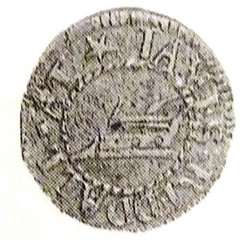
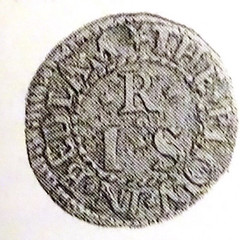
THOMAS BONNY AT THE
Clothworkers' Arms
Reverse
IN BEDLAM HIS HALFE PENNY
1667
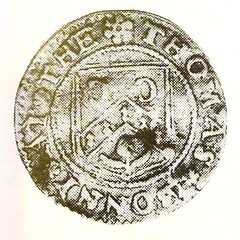
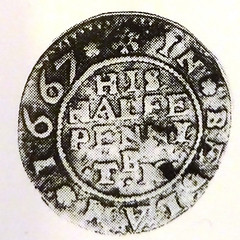
1662 London W.189, Old Bethlem, Thomas Leare, Farthing Token
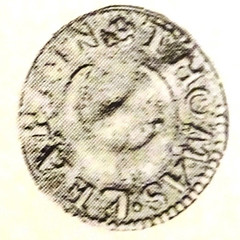
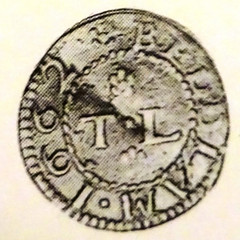
Thanks to Charles Riley for assistance
http://www.charlesriley.co.uk/
To read the earlier E-Sylum articles, see:
ADVENT COINS: A GAME OF THRONES
(https://www.coinbooks.org/v23/esylum_v23n48a25.html)
ADVENT COINS: JOHN THE BAPTIST
(https://www.coinbooks.org/v23/esylum_v23n49a28.html)
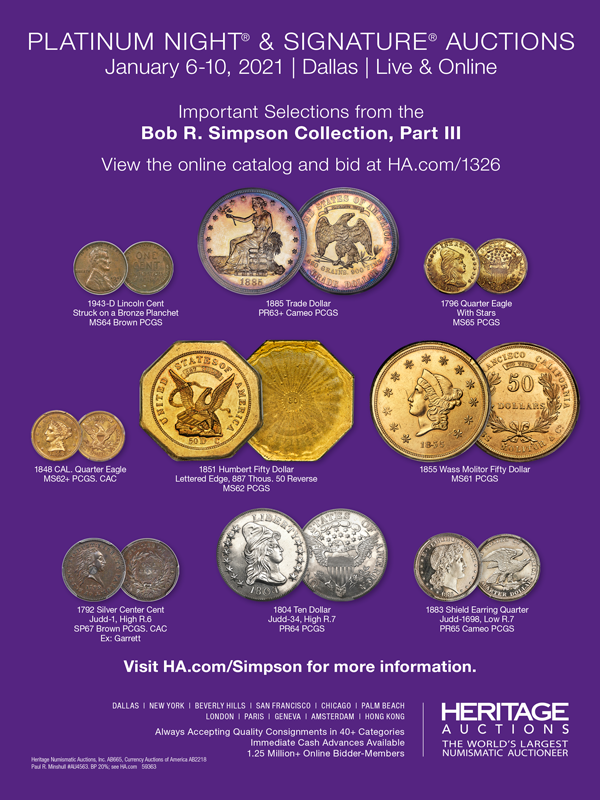
PAPER MONEY DEPICTING JESUS
Jeff Wing submitted a Christmas article as well, on paper money. Thank you! -Editor
 The decorations, music, gatherings, and television let us know that it is the Christmas season.
However, do these items emphasis the real "Reason for the Season?" Likewise, many consider
the fact that US money states "In God we Trust," to be inspirational since it shows that the US is
based on faith. Do other countries depict Christian faith? To answer this question, I performed
much research and found the answer to be a resounding "Yes." This led me to write the book
Paper Money Messages – Vol 3 (Christianity).
The decorations, music, gatherings, and television let us know that it is the Christmas season.
However, do these items emphasis the real "Reason for the Season?" Likewise, many consider
the fact that US money states "In God we Trust," to be inspirational since it shows that the US is
based on faith. Do other countries depict Christian faith? To answer this question, I performed
much research and found the answer to be a resounding "Yes." This led me to write the book
Paper Money Messages – Vol 3 (Christianity).
I have provided two examples of paper money below that depicts Jesus. The notgeld set (emergency money) from Germany explains the Christian story and I have provided Bible scriptures to help better explain the images. I hope that everyone is healthy and safe during this Christmas season.
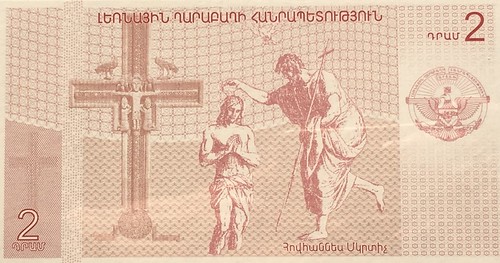
2004 Nagorno Karabakh 2 Dram (Jesus Christ and John the Baptist)
The 1921 notgeld 50 pf set from Kahla depicts the Christmas Nativity story. These notgeld depict a story of hope that was predicted over 1,000 years prior in the Old Testament.
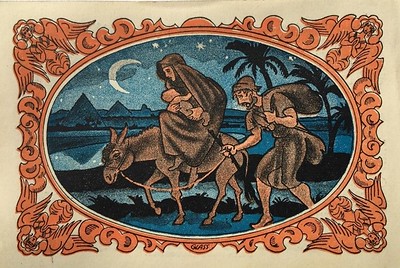
So Joseph also went up from the town of Nazareth in Galilee to Judea, to Bethlehem the town of David, because he belonged to the house and line of David. He went there to register with Mary, who was pledged to be married to him and was expecting a child. Luke 2:4-5 (NIV)

And there were shepherds living out in the fields nearby, keeping watch over their flocks at night. An angel of the Lord appeared to them and the glory of the Lord shone around them, and they were terrified. But the angel said to them, "Do not be afraid." I bring you good news of great joy that will be for all the people. Today in the town of David a Savior has been born to you; he is Christ the Lord. Luke 2:8-12 (NIV)

When the angels had left them and gone into heaven, the shepherds said to one another, "Let's go to Bethlehem and see this thing that has happened, which the Lord has told us about." So they hurried off and found Mary and Joseph, and the baby, who was lying in the manger. Luke 2:15-16 (NIV)

While they were there, the time came for the baby to be born, and she gave birth to her firstborn, a son. She wrapped him in cloths and placed him in a manger, because there was no room for them in the inn. Luke 2:6-7 (NIV)
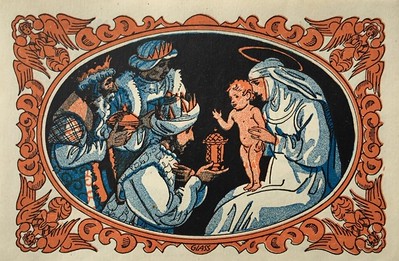
When they saw the star, they were overjoyed. On coming to the house, they saw the child with his mother Mary, and they bowed down and worshiped him. Then they opened their treasures and presented him with gifts or gold and of incense and of myrrh. Luke 2:10-11 (NIV)
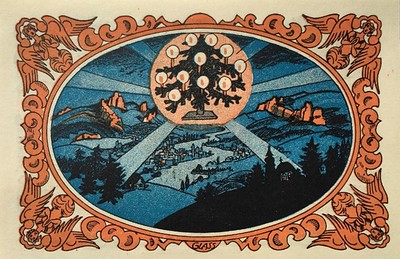
Although a decorated tree is a Christmas tradition, one is not mentioned in the Bible. Prior to Christianity, placing trees in a house was a part of solstice celebrations. In many countries it was believed that evergreens would keep away evil spirits.
For more information, or to order, see:
https://papermoneymessages.com/
To read the earlier E-Sylum article, see:
NEW BOOK: PAPER MONEY MESSAGES (CHRISTIANITY)
(https://www.coinbooks.org/v22/esylum_v22n42a06.html)
BANK OF ENGLAND FATHER CHRISTMAS £5 POSTCARD
In a December 9, 2020 email, the Bank of England Museum published an image of this great Christmas postcard from their collection. -Editor

It's from our collection and a firm favourite of ours. A rosy-cheeked Father Christmas is poking his head through a 'Bank of Friendship' £5 note. We love the tiny Father Christmas in the top left - he's even signed the note as Chief Cashier!
For more information, see:
https://www.bankofengland.co.uk/museum/

MOVIE REVIEW: THE MILLION POUND NOTE
With lots of us spending much time at home these days, it's a nice opportunity to catch up on some great old films we might have missed. One such old film is the 1954 production based on the Mark Twain story "The Million Pound Bank Note". Here's a retro review from the Sunday Observer. -Editor
What 'currency' does a 'banknote' have? The question itself might sound utterly senseless and absurd. However, it is this supposition that becomes the premise for a wager that one may say is something of 'financial philosophy' between the wealthy and eccentric Montpelier brothers in London that sets off the events that form the comedic and somewhat exciting 'The Million Pound Note'. A work of British cinema from 1954 with Hollywood screen legend Gregory Peck in the lead role as the penniless American seaman Henry Adams, this film directed by Ronald Neame is based on the short story The Million Pound Bank Note by Mark Twain.
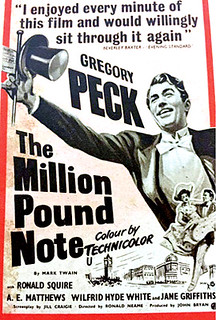 The story takes place in London in 1903. American seaman Henry Adams, played brilliantly by Gregory Peck, is stranded penniless in Britain and desperate to find work so that he may have some means of sustenance and be able to get back home.
The story takes place in London in 1903. American seaman Henry Adams, played brilliantly by Gregory Peck, is stranded penniless in Britain and desperate to find work so that he may have some means of sustenance and be able to get back home.
He is spotted while walking on the streets of London by two wealthy, eccentric brothers, Oliver and Roderick Montpelier who invite him into their opulent home and unknown to him, get him involved in their intriguing wager.
The Montpellier brothers have persuaded the Bank of England to issue a one million pound banknote, which they present to Adams in an envelope, only telling him that it contains some money. The basis of the wager that the two brothers have is that Oliver believes that the mere existence of the note will enable the possessor to obtain whatever he needs, while Roderick insists that it would actually have to be spent for it to be of any use.
Weary and famished, Henry who leaves the Montpelier house with the envelope, steps into a small restaurant and treats himself to a large hearty meal, twice over! And when it comes to the point of settling the bill, he opens the envelope to find that the sum of money inside it is in fact a one million pound note issued by the Bank of England.
The waiter, the proprietor and his wife, who operate the restaurant, are stunned beyond belief and come to the conclusion that Henry is an eccentric millionaire. They fawn before him and tell him that as they cannot change the banknote and give him his balance for payment of meal and therefore, it is gladly 'on the house' as they feel privileged to have served such a distinguished wealthy man as he, and further, bid Henry to come to their humble establishment to dine whenever he wishes.
The situation overwhelms Henry. He rushes over to the house of the Montpelier brothers to return the banknote. However, Henry learns they have gone abroad for a month.
The letter enclosed along with the million pound banknote in the envelope says that if Henry can return to them in a month with the banknote, having not cashed it, they will provide him a job, since Henry was in need of one. Realising that he has no choice but to wait for a month until the Montpelier brothers return, Henry realises the opportunity of 'getting by' is now within his possibilities by the possession of the banknote, by getting things on credit on the mere presentation of the fortune he carries in the form of a single banknote.
What follows is a whirlwind of skyrocketing social mobility for Henry who soon becomes the toast of London town! The newspapers celebrate him as the American millionaire with a one million pound banknote.
Found via News & Notes from the Society of Paper Money Collectors (Volume VI, Number 24, December 1, 2020). -Editor
To read the complete article, see:
The Million Pound Note
(http://www.sundayobserver.lk/2020/11/29/montage/million-pound-note)
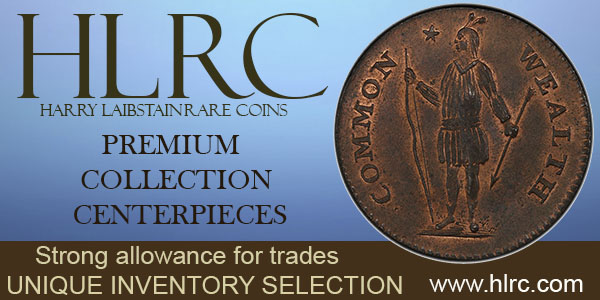
U.S. POST-WWII GERMANY BARTER UNIT CERTIFICATES
An item in the German Geldscheine Online newsletter this week caught my eye. Illustrated with a lot image from Heritage, it describes the post-WWII "Barter Unit" certificates of the US occupation forces in Germany. Here is the Google-translated article text. I wasn't aware of these - very interesting emergency money issue. -Editor
Lexicon: Barter Units
At the instigation of the US occupation zone in Germany, so-called barter stores were opened in 1946 based on the pattern of the previously existing exchange ring stores, initially only in Berlin, then also in Frankfurt am Main. Items that were made available by American soldiers and essential for the German population were exchanged for expendable items.
The bringer received no money, but barter units (also called barter units certificates), i.e. exchange money, the value of which was denominated in units and entitled to redemption for items with the same unit value.

Exchange money via 1 barter unit of the US occupation forces in Germany, Frankfurt am Main, series 1946, front and back, fig. Heritage Auctions.
The exchange money in the Berlin store was 1, 50, 10, 25, 50 and 100 units.
The exchange money for the Frankfurt business, which existed until the currency reform in 1948, was issued in the same values ??as in Berlin, but in several different editions. There were also fakes of the barter units.
Today the Barter Units are consistently rare historical evidence of the Allied occupation of Germany.
To read the complete article, see:
Lexicon: Barter Units
(https://www.geldscheine-online.com/post/lexikon-barter-units)
The article didn't include a link, but I was able to locate item on the Heritage website. It was sold in the January 2006 FUN sale. -Editor
To read the complete lot description, see:
U.S. Military Barter Certificate 1 Barter Unit 1946. An interesting piece of scrip which may have served as a precursor to t...
(https://currency.ha.com/itm/military-payment-certificates/us-military-barter-certificate-1-barter-unit-1946-an-interesting-piece-of-scrip-which-may-have-served-as-a-precursor-to-t/a/396-16084.s)

BEP CHOOSES ARCHITECTS FOR NEW FACILITY
The Architect's Newspaper published an article December 8. 2020 about the awarding of a contract to design the BEP's new DC-area production facility. -Editor
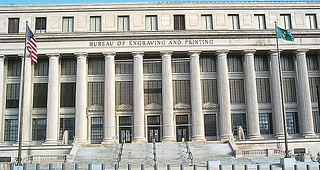 Skidmore, Owings & Merrill (SOM) has announced that it has been chosen to design, master plan, and engineer a new currency production facility operated by the United States Department of Treasury's Bureau of Engraving and Printing (BEP). With the formal announcement, the firm will now join a joint venture, the Capital Currency Team (CCT), that also includes industrial engineer Ghafari Associates and MEP engineer Huitt-Zollars and is administered by the U.S. Army Corps of Engineers, Baltimore District.
Skidmore, Owings & Merrill (SOM) has announced that it has been chosen to design, master plan, and engineer a new currency production facility operated by the United States Department of Treasury's Bureau of Engraving and Printing (BEP). With the formal announcement, the firm will now join a joint venture, the Capital Currency Team (CCT), that also includes industrial engineer Ghafari Associates and MEP engineer Huitt-Zollars and is administered by the U.S. Army Corps of Engineers, Baltimore District.
Described in a press announcement "as modern, more efficient, and highly sustainable," the new production hub, to be located in the National Capital Region, will replace an existing, aging Washington, D.C. production facility in the BEP's neoclassical Main Building and Annex Building, which date back to 1914 and 1938, respectively. Once completed, the new D.C.-area plant will join the BEP's Western Currency Facility in Fort Worth, Texas, as one of two literal money-making factories for the federal government. Production kicked off at the Fort Worth location in 1990 and it was officially dedicated the following year.
"This building has to be a sustainable, secure, and highly digitized production facility that relies on smart manufacturing, all while adapting to the BEP's East Coast currency production requirements over the next century," said SOM Design Partner Chris Cooper in a statement. "This project will be about thinking critically to balance numerous important, and sometimes competing, needs."
As detailed by SOM, the BEP, founded in 1862, is the largest producer of government security documents in the U.S. and prints military commissions and award certificates, event invitations and admission cards, forms, and other government-issued documents in addition to Federal Reserve Notes (aka paper currency). From 1894 through 2004, the bureau was also responsible for the printing of U.S. postage stamps.
While the Fort Worth production facility was pivotal in helping the BEP meet increased production needs when it went online 30 years ago, its older eastern counterpart has long been in need of an updated, state-of-the-art home. As SOM points out, the Washington, D.C. facility is spread across multiple floors, an inefficient approach that essentially segregates different elements of the production process. The new facility will streamline the process and "support the BEP's vital economic role for the next century."
Per SOM:
"The new building will consolidate many program functions, including administrative support and banknote manufacturing, onto a single floor to enable a seamless and more cost-effective operation. It will be equipped with the next generation of secure banknote production technologies, and with up to one million square feet of space, it will be future-proofed to accommodate the changing needs of currency production over time. Additionally, the facility will be designed in accordance with federal security standards."
Site selection is currently pending an environmental impact review with construction expected to kick-off in 2022. It's anticipated that the new facility will be up and printing in 2025.
To read the complete article, see:
SOM will design the new production facility for the Bureau of Engraving and Printing
(https://www.archpaper.com/2020/12/som-new-production-facility-bureau-of-engraving-and-printing/)
To read the earlier E-Sylum articles, see:
LOOSE CHANGE: MARCH 31, 2019 : BEP To Build New D.C. Facility
(https://www.coinbooks.org/v22/esylum_v22n13a32.html)
MORE ON THE POTENTIAL BEP MOVE
(https://www.coinbooks.org/v22/esylum_v22n14a16.html)

FORREST FENN FORTUNE FINDER FOUND
Perhaps there was a real Forrest Fenn treasure chest after all. A man has come forward identifying himself as the finder. -Editor

A decade ago, Fenn hid his treasure chest, containing gold and other valuables estimated to be worth at least a million dollars, somewhere in the Rocky Mountains. Not long after, he published a memoir called The Thrill of the Chase, which included a mysterious 24-line poem that, if solved, would lead searchers to the treasure. Fenn had suggested that the loot was secreted away at the place where he had envisioned lying down to die, back when he'd believed a 1988 cancer diagnosis was terminal. Since the hunt began in 2010, many thousands of searchers had gone out in pursuit—at least five of them losing their lives in the process—and the chase became an international story.
So many people had invested and sacrificed so much in pursuit of Fenn's treasure that it was possible the finder would face threats, be they legal or physical, from people who resented them or wished them ill.
And that was exactly what was beginning to play out.
This past June, Fenn announced that the treasure had been found by a man from "back east" who wanted to remain anonymous—even, once we were in contact, to me. So despite exchanging dozens of emails with the finder, and discussing the details of the chest and what locating it meant to him, I never pressed him about who he was, and he never volunteered.
Last week, he told me the situation had changed. Fenn had been targeted by lawsuits both before and after the chest was found, by hunters claiming that the treasure was rightfully theirs. One of the lawsuits, filed immediately after Fenn announced the hunt was over, also targets the unknown finder as a defendant, claiming that he had stolen the plaintiff's solve and used it to find the chest. That litigation had advanced to a procedural stage during which the finder expected his name would likely come out in court. So while he remained guarded about his solve and the location where he discovered the treasure, he now didn't mind telling me who he really was.
And that's when I learned that a 32-year-old Michigan native and medical student was the person who had finally solved Fenn's poem. His name is Jack Stuef.
As the hunt took up more and more of his time, Stuef mostly kept the extent of his pursuit hidden from friends and family. He didn't think they would understand.
"I think I got a little embarrassed by how obsessed I was with it," Stuef says. "If I didn't find it, I would look kind of like an idiot. And maybe I didn't want to admit to myself what a hold it had on me."
Two years later, he had achieved what so many other searchers could not, finding and claiming Fenn's treasure. (Stuef's status as the finder was independently verified with the Fenn family.) He retrieved the chest on Saturday, June 6, 2020, in Wyoming, and began the long drive down to Santa Fe to deliver it to Fenn that same day. That evening, news of the find was already beginning to come out, as Fenn believed it must. "'We should let [searchers] know as soon as you have it,'" Stuef says Fenn told him.
"His thought was that, as soon as it's out of place, we need to let people know," Stuef says. "People have died. There could be issues."
Stuef asked Fenn, though, that he be allowed to remain anonymous, and they both seemed to agree that the location of the find should be kept secret.
But controversy quickly swirled, as many hunters, unsatisfied with the lack of disclosure, decided this meant that something nefarious was afoot—that Fenn had never really hidden the treasure, or that he had unilaterally ended the hunt without a real finder. The backlash took Fenn by surprise, according to those around him. To address it, several weeks after the find, he released photos of the chest and of himself going through it after Stuef delivered it to Santa Fe, which provided enough confirmation for some. In July, Fenn suggested to Stuef that they also reveal the state where the treasure was found, in order to give further closure to some hunters. Stuef agreed.
I'm glad to see this development. When hoard finders remain anonymous, questions remain unanswered and without proof there's no way to believe any of what people are saying. The article's author Daniel Barbarisi has been writing a book on the Forrest Fenn treasure hunt that will be published in June 2021. -Editor
To read the complete article, see:
The Man Who Found Forrest Fenn's Treasure
(https://www.outsideonline.com/2419429/forrest-fenn-treasure-jack-stuef#close)
Thanks also to Paul Horner and others for passing the story along. -Editor
To read other articles, see:
Man who found Forrest Fenn's famed treasure reveals identity
(https://news.yahoo.com/man-found-forrest-fenns-famed-195935540.html)
Finder of Rocky Mountain treasure chest identified as 32-year-old medical student
(https://abcnews.go.com/US/finder-rocky-mountain-treasure-chest-identified-32-year/story?id=74603009)
Man Who Found Hidden Treasure in the Rocky Mountains Is Revealed
(https://www.nytimes.com/2020/12/07/us/forrest-fenn-treasure-chest.html)
Treasure hunters claim finder's lack of details raises 'red flags'
(https://nypost.com/2020/12/12/treasure-hunters-finders-lack-of-details-raises-red-flags/)

UZBEKISTAN'S MINI GOLD BARS
Kavan Ratnatunga passed along articles and a video about a new gold product issued by the Central Bank of Uzbekistan. -Editor
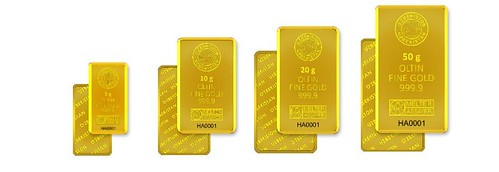
Since November 2020, the central bank of Uzbekistan (CBU) issues sealed gold bars with a QR-code for real time verification. With these new bars CBU aims to stimulate gold to be used as a store of value, as well as promote the circulation of gold.
The new gold bars issued by CBU have a special protective packaging, which includes three security layers: a unique serial number, a QR-code for real time digital authenticity verification, and a membrane that changes color when broken.
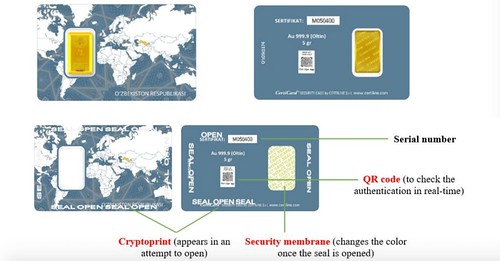
The gold bars are 999.9 fine, available in weights of 5, 10, 20 and 50 grams, and their packages all have the size of payments cards. The gold bars are sold through twenty-eight commercial bank offices throughout the country. At any point in time the bars can be sold back to the dealing banks, even if the seal is broken. Navoi Mining and Metallurgical Combinat (NMMC), an LBMA accredited refinery, is responsible for sourcing the gold, and the packaging technology was developed in cooperation with Certiline.
Previously, CBU only sold commemorative gold coins of one troy ounce. But one troy ounce of gold is worth a fortune for an average citizen in Uzbekistan. Through the new bars in small weights, and the buyback guarantee, CBU aims to make gold accessible to more people as a savings instrument and for large payments.
Kavan adds:
"When will the USA follow with a real non-fiat currency?"
To watch a YouTube video, see:
Gold bars
(https://www.youtube.com/watch?v=gMAjMzFnLAg)
To read the complete articles, see:
CENTRAL BANK OF UZBEKISTAN INTRODUCES PARALLEL CURRENCY: GOLD
(https://www.goldbroker.com/news/central-bank-uzbekistan-introduces-parallel-currency-gold-2052)
Central Bank launches sale of gold measured bars
(http://www.uzdaily.com/en/post/61256)

CASH, COINS AND COVID SEMINAR
The Mint Directors Conference (MDC) is an industry organization of government mints worldwide. Well aware of the challenges facing cash in general and the COVID pandemic shortages in particular, the group is offering a Zoom seminar titled Cash, Coins and COVID: The Perfect Storm. Registration seems to be open to all, so perhaps some curious readers will want to listen in. It starts at 11AM London time Tuesday December 15, 2020. Here's the announcement. -Editor

MDC Webinar: CASH, COINS AND COVID – THE PERFECT STORM
Prior to the COVID-19 pandemic, coin circulation faced challenges. Although coins are a payment instrument in their own right, they are, of course, only one part of the cash cycle. Any consideration of the impact of COVID on coins starts with the wider payment scene to provide the full picture.
This webinar will first review the ongoing challenges facing coins, before examining in more depth what has happened to payments since March, considering circulation data, payment surveys and payment reports. Clearly Europe is different from Africa which is different from Asia etc. In the mix is not just how consumer payments are now being made, but also the rapid development of RTGS systems, developments in non-bank payment systems and the shadow of Libra (Diem) and China's CBDC, all of which aim to transform payments.
How do we forecast the future when the past cannot be used to predict it? There are key indicators that enable non-cash payments, and it is possible to segment societies according to how they prefer to pay. But how to then model this?
Finally, some thoughts on how to approach sustaining cash beyond just cutting costs.
Although this webinar will start and end with coins, it seeks to allow us all to think more widely about cash as just one payment option.
SPEAKERS
Ross MacDiarmid
CEO @Royal Australian Mint
Astrid Mitchell
CEO @Reconnaissance International
Astrid Mitchell, CEO of Reconnaissance International, is also editor of Currency News, a position she has held since it was established in 2003, along with the producer of related publications in the banknote and coins sectors and Director of the biennial Coin Conference.
John Winchcombe
Consultant (Currency and Payments) @Reconnaissance International
John Winchcombe has worked with central banks on the design, issue and circulation of banknotes from joining De La Rue in 1988 to today. His De La Rue career has included working in banknote paper mill and print works, responsibility for new product development of paper, polymer, print, machine readable and optical features for banknotes and marketing strategy. John's last job at De La Rue was four years as Product Development and Marketing Director for the Currency business. Forecasting and market intelligence were a key part of this role. During John's time at De La Rue he worked closely with the Royal Mint.
For more information, or to register, see:
MDC Webinar Registration
(https://zoom.us/webinar/register/WN_fKVk1HjXRyWcOcioG-QNVA)

LOOSE CHANGE: DECEMBER 13, 2020
Here are some additional items in the media this week that may be of interest. -Editor
Book Review: Ancient Coins in Early American Auctions
In the December 10, 2020 CoinsWeekly newsletter, Ursula Kampmann reviews Dave Fanning's new book Ancient Coins in Early American Auctions, 1869-1939. -Editor
 To read the complete article, see:
To read the complete article, see:
A Contribution to Provenance Research
(https://coinsweekly.com/a-contribution-to-provenance-research/)
To read the earlier E-Sylum articles, see:
NEW BOOK: ANCIENT COINS IN EARLY AMERICAN AUCTIONS
(https://www.coinbooks.org/v23/
esylum_v23n38a02.html)
REVIEW: ANCIENT COINS IN EARLY AMERICAN AUCTIONS
(https://www.coinbooks.org/v23/
esylum_v23n42a06.html)
ANS Seeks Curatorial Assistant
The ANS is seeking a Curatorial Assistant for the Roman Republican Die Project. -Editor
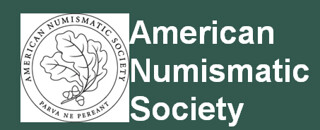 The American Numismatic Society (ANS) is seeking to hire an RRDP Curatorial Assistant. The successful candidate will analyze Richard Schaefer's digitized archive of Roman Republican Dies on Archer and transcribe the relevant data onto spreadsheets for the final publication of the archive on a Collective Access platform. There may be opportunities for co-authored publications with the primary investigators.
The American Numismatic Society (ANS) is seeking to hire an RRDP Curatorial Assistant. The successful candidate will analyze Richard Schaefer's digitized archive of Roman Republican Dies on Archer and transcribe the relevant data onto spreadsheets for the final publication of the archive on a Collective Access platform. There may be opportunities for co-authored publications with the primary investigators.
The ideal candidate should hold an MA, or equivalent in Ancient History, Classics or Classical Studies – a PhD in a relevant field is a plus. S/he should be detail-oriented and have a good level of knowledge of Roman Republican History and of Roman Numismatics. Previous experience in the field of Digital Humanities, especially with databases and statistics is preferred, as well as a sufficient knowledge of French, German and Italian to read catalogue entries.
To read the complete job description, see:
Roman Republican Die Project (RRDP) Curatorial Assistant
(http://numismatics.org/about/employment/)
New Zealand Fake Money Drop Riot
In the shades-of-the-WKRP-turkey-drop department, here's a tale from down under of a marketing stunt gone ugly. -Editor
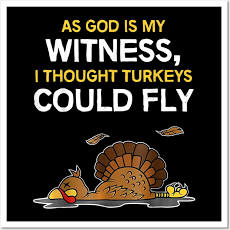 Police have confirmed they are now reviewing a stunt that was pitched as a $100,000 money drop in downtown Auckland - but which turned out to be mostly fake cash.
Police have confirmed they are now reviewing a stunt that was pitched as a $100,000 money drop in downtown Auckland - but which turned out to be mostly fake cash.
The Reserve Bank has also issued a warning that it is illegal to publish anything resembling a genuine banknote after fake $5 notes rained down on people clambering for what they thought was cash.
Safety Warehouse is under siege from furious members of the public who attended Saturday's event in Aotea Square. The company pledged to giveaway $100,000 in cash but the crowd turned ugly when many realised pretend $5 notes - which could be used as a discount - were being distributed.
To read the complete article, see:
Safety Warehouse fake money fury: Police now reviewing Aotea Square giveaway
(https://www.nzherald.co.nz/nz/safety-warehouse-fake-money-fury-police-now-reviewing-aotea-square-giveaway/CVJV5NLAFJTTBYDCAKAUV2KA2Q/)
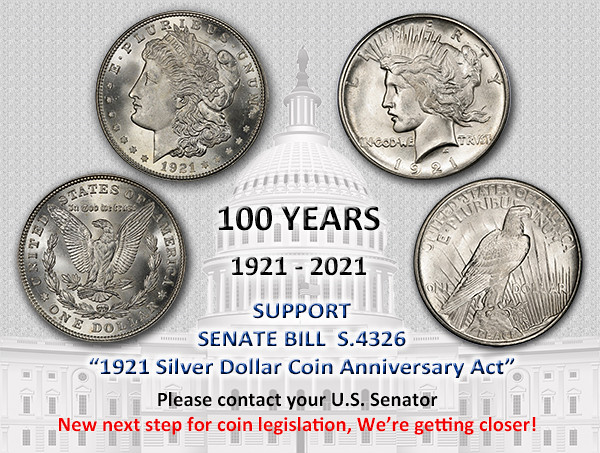
BIG COIN: THE GIANT TOONIE
In the really-big-coin department, this week I came across two Atlas Obscura articles about larger-than-life coin sculptures. Great companions to Sudbury's Big Nickel (see the earlier E-Sylum article. Here's the Giant Toonie. -Editor

WHEN DRIVING NEAR THE CANADIAN town of Campbellford, visitors may miss this 27-foot tall statue of the iconic silver and gold two dollar coin. The trees that surround the monument tend to obscure it from public view.
The coin was constructed in 2001 as a monument to Canadian nature artist Brent Townsend, who created the now-iconic polar bear image on the tails side of the coin. Townsend created the artwork in Campbellford, thus deeming this quiet riverside town the birthplace of the two-dollar coin. The town was proclaimed, "The Home of the Two Dollar Coin" in 1997 by the Canadian Mint.
The giant statue isn't the first monument to the town, as the first stood just a couple feet from the giant coin. The current monument also features the queen on the other side, facing the town. The date on the coin reflects the day the monument was complete, 1996.
To read the complete article, see:
Giant Toonie
(https://www.atlasobscura.com/places/giant-toonie)
To read an earlier E-Sylum article, see:
BOOK REVIEW: THE BIG NICKEL: THE UNTOLD STORY
(https://www.coinbooks.org/esylum_v17n32a06.html)
BIG COIN: THE BIATEC MONUMENT
The Biatec Monument pictures a rare Celtic coin design popular in Bratislava. Impressive! -Editor
Biatec Monument
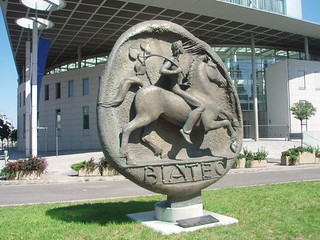 IT'S UNCLEAR WHO BIATEC WAS. The name appears on the coins that circulated among the Celtic tribe of the Boii, minted in what is present-day Bratislava around 60-40 B.C. These rare ancient coins are also referred to as Biatec (or Biatex) by modern scholars. Although this has not been confirmed, it was likely the name of the leader of the tribe.
IT'S UNCLEAR WHO BIATEC WAS. The name appears on the coins that circulated among the Celtic tribe of the Boii, minted in what is present-day Bratislava around 60-40 B.C. These rare ancient coins are also referred to as Biatec (or Biatex) by modern scholars. Although this has not been confirmed, it was likely the name of the leader of the tribe.
Generally sizing 25 millimeters (just under an inch) in diameter and weighing about 17 grams, the silver coins were equivalent of Hellenistic hexadrachms or tetradrachms, which they are believed to have imitated. Fourteen hoards consisting of these coins were unearthed in the 20th century, six of them in Bratislava.
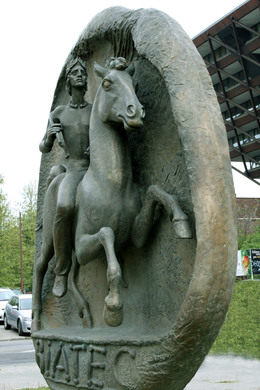 The obverse usually showed a bust or two facing right, while the reverse was a horseman or an animal, both mythological and real, such as the griffin, lion and boar. Under the reverse figure was an inscription in capital Latin letters. There are 14 known types of inscriptions, but the one that appears the most frequently was BIATEC, sometimes shortened to BIAT.
The obverse usually showed a bust or two facing right, while the reverse was a horseman or an animal, both mythological and real, such as the griffin, lion and boar. Under the reverse figure was an inscription in capital Latin letters. There are 14 known types of inscriptions, but the one that appears the most frequently was BIATEC, sometimes shortened to BIAT.
Although rather obscure internationally, the Biatec coin has become a sort of icon in Slovakia. From 1993 to 2008, its design was featured on the five-Slovak koruna coin, and even today, the horseman can be seen on the National Bank of Slovakia's logo.
In 1988, a bronze monument shaped after and commemorating the Biatec coin was created by sculptress Ludmila Cvengrošová. More than a hundred times larger than its real-life counterpart, the monument was 3 meters (10 feet) in diameter and weighed 3 tons. It was relocated in front of the National Bank of Slovakia in 2008, one month before the country's transition from the Slovak koruna to euro.
To read the complete article, see:
Biatec Monument
(https://www.atlasobscura.com/places/biatec-monument)
To read an earlier E-Sylum article, see:
BOOK REVIEW: THE BIG NICKEL: THE UNTOLD STORY
(https://www.coinbooks.org/esylum_v17n32a06.html)

FEATURED WEB SITE: WAR WORK TOKENS
This week's Featured Web Site is Mark Smith's War Work Tokens: The Tokens, Checks & Passes of the British Munitions, Ordnance & Military Supply Industries.
This website aims to act as a hub for disseminating information and research related to the subject of tokens, checks and passes (i.e. paranumismatics) associated with British ordnance and munitions manufacture as well as military supply industry activities (i.e. War Work) in the British Isles. The site's principal period of focus is the Great War (1914 to 1918) although related tokens prior to this period as well as from the Second World War (1939 to 1945) and inter-war years are also included.
A longer term aim of this site will be to list, and wherever possible, illustrate all known types of paranumistmatics related to the above stated subject matter. The bulk of the tokens discussed were used by civilian workers employed in the manufacture of armaments (including airplanes and ships), weapons, explosives, munitions, military equipment and uniforms etc. at either privately owned or, more often, British Government operated specialist factories. These were located throughout the length and breadth of the United Kingdom.
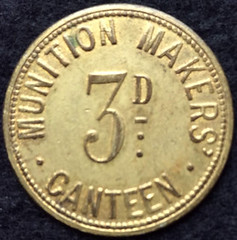
https://war-work.com/

